Bellwether
Special Species Clinic Special Species Clinic
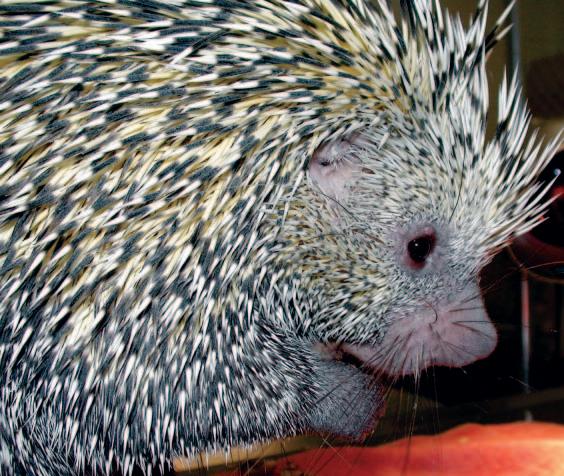
INSIDE
A Message from the Dean2

Environmentally Friendly Manure6
Mouse Eggs fromEmbryonic Stem Cells7
Rosettes &Ribbons8
Teaching Awards10
V.M.D.Notes14
Animal Crackers27
SpecialGifts28
Saratoga Comes to Philadelphia! 31

Penn Veterinary Medicine
Commencement12 Alumni Weekend20 Page 4 Page 4 NO.57 • SUMMER 2003 THE NE WSMAGAZINE OF THE UNIVERSITY OF PENNSYLVANIA SCHOOL OF VETERINARY MEDICINE
AMessage from the Dean
Last November the American Association of Veterinary Medical Colleges,representing all the veterinary schools in the U.S.and Canada, held a conference at the National Press Club in Washington D.C., entitled,“An Agenda for Action:Veterinary Medicine’s Role in Public Health and Biodefense and the Obligation ofAcademic Veterinary Medicine to Respond.”
I am pleased to say that the conference was largely initiated and sponsored by Penn.
The conference centered on the nature of the biological threats,either accidental or deliberate,that may affect human and domestic animal populations in North America.The role ofthe veterinary profession is emphasized in the executive summary: The training ofveterinarians creates a cadre ofprofessionals who are ideally suited to respond to and counter these threats, but prompt and sustained action by the profession and its leadership is required.
Equally important,those in positions of leadership in the United States must recognize and nurture this capability ofthe veterinary profession,as it is a precious and crucial national resource.
The call for prompt and sustained action refers to the ever increasing complexity of newly emerging,and re-emerging infectious disease, and the threat ofdrug-resistant pathogens.
World population growth,poverty,overcrowding,squalor,lack ofhealth care,global warming,and our rapid transition to a global society,with a globalized food supply,all contribute to the complexity and reality ofthe threat.Pathogens,particularly those that in the past were brushed aside as causing bizarre diseases in far away places,are finding new niches and establishing infections in our own environment.West Nile virus encephalitis, Nipah virus encephalitis,SARS,mad cow disease,and most recently monkey pox,make this point abundantly clear as all are diseases transmissible to man.
Add to the above the threat ofbioterrorism and the call for prompt and sustained action becomes urgently compelling.Since the tragedy
of9/11,and the torment ofthe anthrax episodes,the government has engaged in a highly publicized defense program against smallpox but it has yet to invest heavily in the nation’s public health infrastructure,in veterinary public health,epidemiology,and in research on infectious diseases ofdomestic and wild animals.Yet,I would predict that terrorist threats to the safety ofthe American food supply will create a level offear no less destabilizing than the threat ofsmallpox.
The veterinary profession has a proud history oferadicating and controlling zoonotic diseases (those transmitted from animals to man) and eliminating diseases important to the health ofdomestic animals.Veterinarians were instrumental in removing bovine TB,equine glanders,brucellosis,rabies,and trichinosis,as threats to human health in the U.S.,and in the elimination offoot-and-mouth disease,swine fever,Newcastle disease,and avian influenza as threats to domestic animals during the first half
ofthe 20th century.
These extraordinary contributions are largely unknown because the profession has not done enough to educate the public.Those in leadership positions in our federal and state governments must now be enlightened about how much is at risk ifthe veterinary profession is not encouraged and given the means to become fully engaged.
Our profession,most particularly its academic community,must work to ensure that there are adequate personnel and fiscal resources to support infectious disease research on domestic and wild animals,the source of most new and emerging infectious diseases that endanger our health and food supply.Two years after 9/11,these resources are still distressfully inadequate.
Alan M.Kelly

A plaque in memory of Dr.David Knight was placed in the cardiology suite at the Ryan Veterinary Hospital.Dr.Knight’s widow and their sons,Eric and Christopher,attended the ceremony.
Eric Knight,like his father,an avid bicyclist,made a special trip this spring.He and a group offriends rode more than sixty miles through Lancaster County,taking a route he and his father had planned for that day.Eric wore a sign that read “In Memory ofDad.He Planned to Ride Today.”
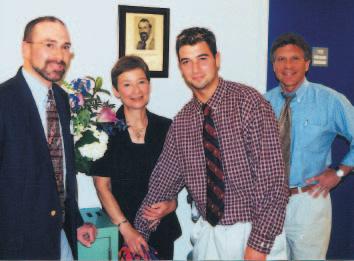
2 BELL
57
WETHER
The Gilbert S. Kahn Dean ofVeterinaryMedicine
Eric Knight, Kr ystyna Knight,Christopher Knight and Dr.Gail Smith.
Teaching and Research Building News

By the fall of2006,the southwestern gateway to the University’s campus changes.At that time faculty,students, and researchers will move into the Veterinary School’s Teaching and Research Building at the confluence ofUniversity, Baltimore,and Woodland Avenues.The Veterinary School,and its new building designed by the Polshek Partnership of New York City,will buttress one side of this new gateway through which thousands ofcars pass every day.

While more than $46 million is in hand,the School is moving ahead on its fund-raising campaign to raise the remaining funds needed to begin construction—perhaps as much as another $8 million.“The final cost ofthe building will be known once cost estimation is complete,”says Mark Stuart,assistant dean for development.“We do have a good sense from other Penn building projects ofour costs per square foot. The original feasibility study called for a $48 million price tag,but with rising construction costs and inflation over the last three years, that previous estimate could not hold.”
Fund-raising highlights
To date,faculty,staff,and alumni have “reserved”close to 160 seats in the building’s two classrooms.The next Bellwether will list the donors to the “Reserve A Seat”campaign.This issue
includes a pamphlet so that our friends have an opportunity to participate.”This is most likely the single best faculty and stafffund-raising campaign ever for a Penn school in terms ofparticipation and total dollars pledged,”says Stuart.
Adding to a previous gift of$500,000, the Allerton Foundation made another commitment of$120,000,making the foundation one ofthe largest contributors to the building effort so far.“Private family foundations have been very generous to the School. More than $4 million have been given or pledged,to date, by these organizations.Many ofthem came to know the School through contact as NBC or Ryan Hospital clients. Their generosity will ensure that we educate the next generation oftalented, skilled veterinarians in the best possible environment for teaching and learning,” says Stuart.
The trust established through the estate of Anna Oschwald has


contributed almost $100,000 to the Teaching and Research Building through monthly distributions.
One ofthe members ofthe School’s Board ofOverseers, Robert F.Fairchild, C’64, of New York City,and president of the House of Burgundy,recently committed $100,000 toward the addition of a “smart”classroom.This teaching space will have the latest electronics for classes ofup to 20 students as well as group study sessions.A special feature ofthis space will be video connection to New Bolton Center and in particular,the Fairchild Aquaculture Building.“Bob’s gift allows us to bridge the 37 miles that divide our two campuses through the latest in conferencing technology.Students and faculty can remain in their respective locations instead ofmaking a two-hour roundtrip.This enables us to offer greater contact between students and faculty on both campuses,”reports Dean Kelly.
BELL WETHER 57 3
Quadrangle Building
Gladys Hall Rosenthal Building
Matthew J.Ryan Veterinary Hospital of the University of Pennsylvania
The Teaching and Research Building site is bounded by University,Woodland and Baltimore Avenues.
EXPANDING THE VISION
Veterinary School Buildings in Philadelphia
Feathers,Scales,and Fur
by Susan I.Finkelstein
On a recent morning at the Ryan Veterinary Hospital,a curious sound could be heard above the meowing and barking that have become the wards’constant chorus.There was no mistaking it:a goose was honking.The noise caused no special alarm to the Ryan staff, though;“Goose-Goose”was simply another patient.
After being mauled by a decidedly quarrelsome dog,Goose-Goose was in need offixing. The domestic brown goose was brought to Ryan Emergency Service by his anxious owner, where his broken bill was set in place by an external metal device and will remain so until healing is complete.Because he must be fed pulverized grain through a feeding tube until his beak fully mends,Goose-Goose has become somewhat of a fixture at Ryan’s Special Species Medicine Clinic—waddling behind students, flapping his wings,and adding a distinct (albeit dissonant) voice to the animal cacophony that is the Ryan Hospital soundtrack.
Unusual pets like Goose-Goose can inspire the same levels ofaffection and devotion in their owners as do the more conventional feline and canine companions that inhabit most of our homes. (In fact,Goose-Goose’s owner expressed his gratitude to Ryan in the form ofa $15,000 donation to the hospital,which will be used to purchase new rigid endoscopes for use in birds and other special species.) “They love their snake, turtle,or ferret just as much as another person loves a cat,”observes Dr.Karen Rosenthal,director ofthe Special Species Clinic,which was established in 2000.“They care deeply and will pull out all the stops to have their pets made well again.”One distressed guinea-pig owner recently paid several thousand dollars for the diagnosis and treatment of his cardiacchallenged pet.
Dr.Rosenthal and staff veterinarian Matthew Johnston,V’99,see all ofthe approximately 900 rabbits, rodents,birds, ferrets,reptiles,big cats,and sundry other exotic

animals treated at the Clinic each year—a striking display ofendurance by any measure. Dr.Avery Bennett, an internationally recognized exotic animal surgeon,presides over surgery cases.Ofcourse,the assistance offourthyear students on two-week rotations and of nurse practitioner Mary Taylor,who runs the ward and performs routine and repeat tests, complete the team that makes such a large and diverse caseload possible.
In addition to daily referrals from the Emergency Service,the Clinic provides wellness examinations, specialized diagnostics,and care for nontraditional pets.Diagnostic tests include advanced imaging studies such as ultrasonographic and echocardiologic examinations and computed tomography.Among the specialized surgeries offered at the Clinic are pet bird neutering and radical treatment ofrabbit abscesses with antibiotic-impregnated beads.
One ofthe more peculiar types of companion animals cared for at the Clinic is the sugar glider,a nocturnal, five-ounce Australian marsupial that launches its tiny body between treetops much like a flying squirrel.Sugar gliders,which can live fifteen years ifcared for properly,are colony animals that are happiest in multiglider households.They also tend to form a strong bond to one person,especially ifacquired while still young;selling a glider after having it for several years is considered very cruel and almost inhumane. Gliders,attention cravers by nature,have even been known to die from loneliness when neglected by their owners.
The once-uncommon ferret,cousin to weasels,skunks,and otters,now makes its residence in millions ofhomes in the United States—and Clinic staffsee many “businesses” ofthese domesticated pet-shop favorites (“business”is the collective name ofa ferret group).“Ferrets are great pets,especially for
teenagers,”says Rosenthal.“They are funny, easy to keep,and very gentle,as they have been bred for a long time and breeders have selected for a companion temperament.”Like sugar gliders,ferrets that do not receive enough attention and interactive play with their owners,or are caged all day,can become depressed. When it comes to physical illnesses,pets such as birds,rodents,and rabbits often do not exhibit symptoms until they are gravely ill, making treatment difficult,ifnot impossible. Because these small animals are prey species, visible signs ofweakness make them vulnerable to attack in the wild.Removing animals from their natural habitats does not necessarily alter instinctive behaviors.
The Humane Society ofthe United States estimates that some 50 million birds are kept as pets in the United States,placing them behind cats and just ahead ofdogs in terms ofpopularity.Unlike cats and dogs,however,some of the larger pet birds can live up to 100 years, during which time they require specialized diets,chaperoned time outside oftheir cages, and lots ofattention and intellectual stimulation.“Birds are not dogs with feathers,”says Rosenthal. Emotionally neglected pet birds can develop psychological problems that include aggression toward others or compulsive self-
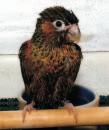
mutilation.Feather picking,a common problem in stressed birds,occurs when the bird substitutes chewing for preening,sometimes causing significant loss offeathers.“Feather picking has physical,psychological,behavioral, and husbandry aspects,”says Johnston.“We work with Dr.Ilana Reisner,director ofthe Ryan behavior clinic,and her group to help the birds.”The exotic animal doctors and behaviorists teach owners how to handle and properly interact with their birds.
Reptiles,too,are enjoying a boom as com-
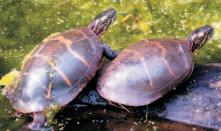
4 BELL WETHER 57
Russian hamster
Baby conure
Painted tur tles
panion animals:an estimated 3 percent of American households own 7.4 million reptiles. “People buy exotic pets,particularly reptiles,in pet stores,”says Rosenthal,“and are not told how to keep these animals,how to feed them, or how to handle them.They are kept under improper light and not given the right food. Remember,many reptiles,particularly iguanas and some species ofsnakes,live in trees,in a humid environment.”A common misconception about the feeding ofsnakes—which have a 20- to 30-year lifespan under optimal conditions—is that they must eat live animals.Not so,says Rosenthal.“It can be dangerous,as the rodent might attack the snake in self-defense and inflict wounds.It’s much better to feed killed rodents,which can be purchased.”
People possessing exotic pets often try to alter the nature ofthe animal rather than the nature ofthe care they provide.Confinement in small barren enclosures,chaining,beating “into submission,”or even painful mutilations such as declawing and tooth removal are tragic ways that some owners try to make their nontraditional companion animals more “user friendly.”Clearly,much can go awry for the many exotic pets that share our homes.
Exotic animals aren’t the only ones who can suffer adverse effects in the households and communities where they have been transformed into pets.Across the country,incidents have been reported in which some ofthe larger exotic pets,such as big cats,have attacked humans and other animals, sometimes after escaping from their enclosures,oftentimes while still in the home.Even animals commonly believed appropriate for children—such as hamsters,gerbils,or mice—“can be nasty and they bite,”says Dr.Johnston.“A rat would be a better pet. Rats are docile,intelligent, and fastidiously clean.They use a litter pan and come in lots ofcolors.They have great personalities and live two to three years. ”
Giant Gambian rats,however,are not as desirable as their domesticated kin.In
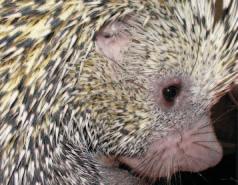
June,after an outbreak ofmonkeypox in three Midwestern states,federal health officials indefinitely banned the import, sale,and shipment ofGambian rats in the United States;prairie dogs and other members of rodent species indigenous to Africa also were part ofthe ban. Monkeypox,a smallpox-related virus,is believed to have originated in Gambian rats and subsequently transmitted to prairie dogs at an Illinois pet store where both species were being housed together.At least 57 people who then handled the infected prairie dogs fell ill.(Monkeypox joins several animal-related diseases from other parts of the world that have appeared in the United States in recent years.AIDS is believed to have crossed to humans from African chimpanzees. West Nile virus—previously confined to Africa, western Asia,and the Middle East—is spread by mosquitoes and birds.Sudden acute respiratory syndrome,or SARS,which has killed at least 812 people worldwide since it first surfaced in November in southern China,likely had its origins in Chinese wildlife markets.)
This is not the first time the government has restricted certain pets due to public-health concerns.African pygmy hedgehogs enjoyed a briefheyday as pets in Pennsylvania households—and made their share ofappearances in the Special Species Clinic—before the Pennsylvania Game Commission barred all ownership last year due to the possibility that they can carry foot-andmouth disease.In 1975,federal officials banned the sale ofvery young pet water turtles when it became known they were the source of14 percent ofall human salmonellosis cases in the country. The same year,officials banned imported monkeys and
other nonhuman primates as pets because they can carry serious diseases like tuberculosis.
Reptiles,including all types ofsnakes and lizards,also pose particular safety risks.Nearly 90 percent ofall reptiles carry salmonella,and humans can be infected by touching a contaminated surface or from contact with an animal’s feces.In addition,many snakes,the most common pet reptile,can cause serious injury through a bite or constriction.
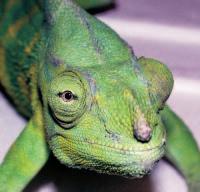
Despite all the inherent risks and difficulties involved in owning an exotic pet,the growing interest in these animals has led to an increase in the amount of information pertinent to their veterinary care,nutrition,and proper housing requirements.Exotic-pet owners today have access to an unprecedented amount of knowledge through clubs and societies,specialty magazines,Internet sites,and scientific publications.Realizing the importance ofinformed owners in the health and longevity oftheir nontraditional companion animals,the Special Species Clinic incorporates education about responsible pet ownership with state-of-the-art diagnostics and treatment.
Appointments for special species can be made by calling the Ryan Veterinary Hospital at (215) 898-4680. In addition, the Emergency Service is available 24 hours a day for these animals,and emergency clinicians always have access to a member ofthe Special Species Medicine Clinic for consultation.The Emergency Service can be reached at (215) 898-4685.
Please check with state agencies to determine which animals are legal as pets.
Dr.Johnston has recently left for the Colorado State University College ofVeterinary Medicine.
BELL WETHER 57 5
Prehensile tail porcupine
Mellers chameleon
Penn Researchers Make Manure a More EnvironmentallyFriendly Fertilizer
By Susan I.Finkelstein
In keeping with the increasing overall awareness ofenvironmental issues,dairy,hog, and poultry farmers across the country face growing governmental regulation and public demand to manage a huge quantity ofanimal manure in an environmentally friendly manner.Using animal manure as a fertilizer is problematic because the large amount ofsoluble phosphorus in manure is prone to runoff losses in waterways,contributing to waterquality problems in many streams,rivers,and estuaries.
Scientists at the School have found an economical and effective way to stabilize manure phosphorus by lowering its solubility using fly ash—the fine,often airborne particles derived from the burning ofcoal.When fly ash materials were mixed with dairy,hog,or broiler manures,water-soluble phosphorus decreased by up to 80 percent.Another additive,alum (aluminum sulfate),also reduced water-soluble phosphorus dramatically.Fly ash materials are easily obtainable at minimum cost from coal-combustion power plants.The results ofthe 2001–2002 study,which was funded by the United States Environmental Protection Agency’s Chesapeake Bay Program, appeared in the July–August issue ofthe Journal of Environmental Quality by the American Society ofAgronomy,Crop Science Society of America,and Soil Science Society ofAmerica. In manure that has been treated with fly ash or alum,highly water-soluble phosphorus shifts to other forms that are less soluble and therefore more stable.The mechanisms responsible for these shifts are precipitation, absorption, and entrapment.Scientists believe
the shifts are desirable and beneficial because the phosphorus available for crops would be similar over the long term,while its environmental losses would be substantially reduced.
“Treating manure with alum or fly ash prior to field application can be a management tactic particularly useful on farms where manure has to be spread during late fall to early spring. These are sensitive times when crops are not growing and phosphorus and other nutrients cannot be utilized while runoffpotential is the highest.With treated manure,phosphorus would have a better chance to stay in the fields until the crops can use it rather than being dissolved in runoffwaters and getting into streams and rivers,”states lead scientist Zhengxia Dou, Ph.D.,at the Center for Animal Health and Productivity at New Bolton Center.Dou was
joined in the research by scientists J.D.Toth and James Ferguson,V’81,both from Penn;G. Y.Zhang ofthe Soil Science Institute,Chinese Academy ofSciences,Nanjing,China;and W. L.Stout,ofthe U.S.D.A.’s Agricultural Research Service in University Park,Pa.
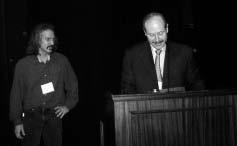
The amounts ofaluminum or heavy metals in soils that have been fertilized with alum- or fly-ash–treated manure are well below the natural levels and within government-regulated limits.“Ofcourse,soils and crops in fields receiving treated manures should be monitored through proper testing to safeguard the health ofanimals and humans,”adds Dou.An integrated,whole-farm management program is most effective in helping producers improve nutrient efficiency,enhance productivity,and minimize adverse environmental consequences.
New Section at New BoltonCenter
New Bolton Center has added a Section of Emergency/Critical Care and Anesthesia.Effective July 1,2003,Emergency Service,Intensive Care and Neonatal Units,and Anesthesia are organized as one cohesive unit.“We have worked on this since 1999,”says Dr Pamela Wilkins,assistant professor ofmedicine and chiefofthe new section.“There is a great need for large animal emergency/critical care specialists; most ofthe ofveterinarians board certified in veterinary critical care are companion animal specialists.There are very few places were people can train in large animal emergency and critical care medicine as there are only ten active clinicians board certified in this discipline nationwide.”
Dr.Wilkins is one ofthem. Under the auspices ofthe new section,the School is developing a residency program in large animal emergency/critical care medicine. “An academic unit puts people oflike minds together,”says Wilkins.
“This is very beneficial for residents and students.It is an emerging specialty and we are formalizing the training. New Bolton Center,with its high caseload,is well suited as a training ground for large animal emergency/
critical care veterinarians.”
New Bolton has always provided 24-hour emergency care and has a long-standing commitment to critical care.Clinicians in the Connelly Intensive Care Unit and the Graham French Neonatal Section have made great strides in the care ofcritically ill large animals in the past decade.There is a special emphasis on neonatal care, particularly during foaling season.These services are augmented by outstanding sections ofsurgery and medicine and a superb nursing staff.The critical care residents will be exposed to all large animals: horses,cows,llamas,alpacas,sheep,goats,pigs, and occasional zoo animals.
The faculty members in the new section are: Drs.Barbara Dallap,V’94, Bernd Driessen, Lin Klein,V’70, Jon Palmer,V’77, Lawrence Soma, V’57, Louise Southwood,and Pamela Wilkins. Staffveterinarians Drs.Brett Dolente,V’96, Janet Johnston,V’96, and Kim Olson are also members ofthe section.Currently,the residents at New Bolton Center training in Emergency and Critical Care are combining this training with standard residency training in allied specialties,such as surgery,medicine,and anesthesia.One focus ofthe Section ofEmergency/Critical Care and Anesthesia will be to formalize training standards for residents in Large Animal Emergency and Critical Care, with a goal ofbeing able to offer standard track training in this emerging specialty.
6 BELL
57
WETHER
Dr.Frank Luca,assistant professor in animal biology,receives the Pfizer Award for Research Excellence from Dr.Pedro Lichtinger,president of the Pfizer Animal Health Group.
Scientists Produce Mouse Eggs from Embryonic Stem Cells
by Steven Bradt
Researchers at the School have created the first mammalian gametes grown in vitro directly from embryonic stem cells.The work, in which mouse stem cells placed in Petri dishes—without any special growth or transcription factors—grew into oocytes and then into embryos,was reported in early May on the website ofthe journal Science.
The results demonstrate that even outside the body embryonic stem cells remain totipotent,or capable ofgenerating any ofthe body’s tissues,said lead researcher Dr.Hans R. Schöler, professor ofreproduction medicine and director ofPenn’s Center for Animal Transgenesis and Germ Cell Research.
“Most scientists have thought it impossible to grow gametes from stem cells outside the body, since earlier efforts have yielded only somatic cells,”said Schöler.“We found that not only can mouse embryonic stem cells produce oocytes,but that these oocytes can then enter meiosis,recruit adjacent cells to form structures similar to the follicles that surround and nurture natural mouse eggs,and develop into embryos.”
Schöler said oocyte development in vitro may offer a new way for embryonic stem cells to be produced artificially,sidestepping the ethical concerns articulated by President Bush and others.Implanting a regular nucleus from any ofthe body’s cells into such an oocyte would yield a totipotent stem cell.
The findings may force legal revisions in nations such as Germany whose lawmakers, assuming that stem cells’potency outside the body was limited,have passed legislation banning research with totipotent stem cells.
The Penn scientists pulled offthis feat using a gene called Oct4 as a genetic marker.After the stem cells were plated in a regular Petri dish—densely but without special feeder cells or growth factors—the scientists used fluorescent markers linked to Oct4 and other telltale genes to assay oocyte development.After 12 days in culture,the cells organized into colonies ofvariable size.Shortly thereafter, individual cells detached from these colonies.
“These germ cells then accumulated a coating ofcells similar to the follicles surrounding mammalian eggs,”Schöler said.“Starting on day 26,oocyte-like cells were released into the
culture—similar to ovulation—and by day 43, embryo-like structures arose through parthenogenesis,or spontaneous reproduction without sperm.”
In the experiment described in Science,both male- and female-derived stem cells developed into female gametes.Schöler and colleagues now plan to test whether oocytes developed in vitro can be fertilized.
“We would like to use these oocytes as a basis for therapeutic cloning,and hope that our results can be replicated with human embryonic stem cells,”Schöler said.
Schöler was joined in the research by Karin Hübner, James Kehler, Rolland Reinbold, Rabindranath de la Fuente,and Michele Boiani ofPenn’s School ofVeterinary Medicine;Lane K.Christenson,Jennifer Wood,and Jerome Strauss III from Penn’s School ofMedicine; and Guy Fuhrmann ofthe Centre de Neurochimie in France.The work was funded by the National Institutes ofHealth,the Marion Dilley and David George Jones Funds,the Commonwealth and General Assembly ofPennsylvania, and the Association pour la Recherche sur la Cancer.
Penn President Judith Rodin to Step Down in June 2004
Judith Rodin, CW’66, president ofthe University ofPennsylvania since 1994,announced on June 20,2003,that she intends to step down from the office when she completes her 10-year term in June 2004.

Rodin became Penn’s president on July 1,1994, coming to Penn from Yale, where she had been Provost.She was the first woman to be named to the presidency ofan Ivy League institution,and the first Penn alumna to serve as president.
During nearly a decade ofservice,Rodin has guided the University through a period of unprecedented growth and development that has transformed Penn’s academic core and dramatically enhanced the quality oflife on campus and in the surrounding community.Under her leadership,Penn has invigorated its
resources, doubling its research funding and tripling both its annual fundraising and the size ofits endowment;created Penn Medicine; launched a comprehensive and widely acclaimed neighborhood revitalization program;attracted record numbers ofundergraduate applicants,creating Penn’s most selective classes ever;risen in the U.S News & World Report rankings oftop national research universities from 16th in 1994 to 4th in 2002; established new interdisciplinary institutes and created over a dozen groundbreaking interdisciplinary,multi-school,undergraduate,and graduate degree programs throughout the University;planned or completed new buildings and major renovations in every school and center;and expanded its international programs and collaborations.Faculty excellence has risen dramatically and there has been significant investment in leading-edge graduate and professional degree programs.
“Serving Penn these past years has been an extraordinary privilege and an exhilarating experience,”Rodin said.“This is a remarkable
community of amazing depth and breadth,and I am grateful to the Trustees for their support and for giving me the opportunity to work with so many talented and creative individuals. I am very proud ofall that our faculty,staff, students,alumni and community partners have together enabled Penn to accomplish.
“The decision to step down has been an extremely difficult one for me to make,but I believe it is the right time for Penn.We have successfully fulfilled our first strategic plan and with the next plan conceived and ready to launch,it is time for the next era ofleadership. I love this institution and will always remain a part ofit.”
The executive committee ofPenn’s Board of Trustees will appoint in the months ahead a presidential search committee,to be comprised oftrustees,faculty,and students,which will be chaired by James S.Riepe,W’65 WG’67,the Board chairman.For more information,visit the “Judith Rodin:An Enduring Legacy” website at <www.upenn.edu/pennnews/ rodin_legacy/>.
BELL WETHER 57 7
Dr.Phillip Scott,professor ofimmunology, has been awarded the 2004 Stoll-Stunkard Memorial Lectureship by the American Society ofParasitologists.The honor is given to a researcher whose prominence in basic research is evident,and who is not necessarily a parasitologist,but one whose research might enhance investigations on parasites,hence fostering cross-fertilization ofideas and approaches.Dr.Scott is recognized for his studies on the immune response to the protozoan parasite, Leishmania.He demonstrated that distinct T-cell subsets are associated with resistance and susceptibility to these parasites.
Sherrill Davison,V’83,associate professor of poultry medicine, Susan Casavant,and the EDGIS unit were awarded the “2003 Pennsylvania Award for Excellence in Geographic Information Technology for the Visionary Application ofGeospatial Technology to Serve the Citizens ofPennsylvania.”Presented at the 2003 Pennsylvania GIS Conference in Harrisburg,the award honors government,business, an academic organization, or exceptional individuals working in the field ofGeographic Information Technologies who have provided exemplary service to the citizens ofPennsylvania. The work being done at New Bolton Center focuses on mapping the locations and attribute information ofthe poultry,swine,dairy,and cattle farms in Pennsylvania primarily for epidemiological purposes.
Secretary/Treasurer ofthe ACPV and has held the position for four years.
Chick Weisse,V’98, lecturer in surgery,passed his board exams and is now a diplomate ofthe American College ofVeterinary Surgeons.At the invitation ofa specialty practice in San Diego,Dr.Weisse and Dr.JeffSolomon of HUP traveled there.They performed percutaneous transvenous coil embolizations of two intrahepatic shunts in a dog and a cat. They also lectured.
Dr.Weisse received a grant from the Morris Animal Foundation to study “Magnetic Resonance Imaging ofCanine Focal Splenic and Hepatic Lesions,”the co-investigators are Drs.Clifford, Skorupski, Sorenmo,Pretorius, Siegelman, Drobatz,and Solomon.
Dr.Adrian R.Morrison,professor ofbehavioral neuroscience,was recognized as a “Significant Early Contributor”to the field ofmodern sleep research at the annual meeting ofthe Sleep Research Society in June in Chicago where REM sleep was first recognized 50 years ago.
fornia,March 2003,”“Animal Welfare in the United States,”and “The Veterinary School at the University ofPennsylvania.”
In July,he conducted the annual meetings ofthe American Association ofAvian Pathologists during the AVMA convention in Denver. Dr.Eckroade is celebrating his 22nd and final year as Secretary/Treasurer and CEO ofthe AAAP.He was presented a Special Appreciation Award by AAAP President Dr.Syed Naqi for his untiring and superb leadership and service. The award was made possible by the generous contributions ofthe AAAP membership.
David M.Nunamaker,V’68,Jacques Jenny Professor ofOrthopaedic Surgery,was the keynote speaker at this year’s Voorjaarsdagen meeting in Amsterdam in April.The lecture was “On Bucked Shins”and “On Bone and Fracture Healing.”
Rosettes & Ribbons
Dr.Leszek Kubin was promoted to research professor ofphysiology.The Heart,Lung,and Blood Institute,NIH,awarded Dr.Kubin a new five-year research grant to study the relationship between respiratory disorders during sleep and central neural mechanisms of diabetes and related metabolic disorders.
some recent accomplishments of note at the School
In June,Dr.Davison attended the Northeastern Conference on Avian Diseases in Portland,Maine and presented two papers entitled: “The Use ofGeographical Information System Technology in the Poultry Industry,” and “Detection ofMycoplasma gallisepticum in Layers Using Sentinel Turkeys.”Dr.Davison conducted the Board meeting ofthe American College ofPoultry Veterinarians in July during the AVMA meeting in Denver.She is
Gail Smith,V’74, resumed duties ofchair ofthe Department ofClinical Studies— Philadelphia after a half-year sabbatical and would like to acknowledge the wonderful job done by Joan Hendricks,V’79,Bower Professor ofMedicine,as interim chair in his absence.
The meeting was held jointly with the American Academy ofSleep Medicine and the World Federation ofSleep Research Societies.As outgoing president ofWFSRS,he chaired the Closing Symposium:Past Accomplishments and New Visions for Sleep Research around the World.Also,the International Union ofthe Physiological Sciences has appointed Dr. Morrison to their newly formed Committee on Ethics.In July,he lectured on Developing an Ethical Perspective on the Use ofAnimals in Research at the annual conference for teachers sponsored by the American Physiological Society.
Dr. Zhengia Dou was promoted to associate professor ofagricultural systems and James Ferguson,V’81,was promoted to professor of nutrition.
In March, Dr.Robert Eckroade,associate professor ofpoultry pathology,presented six papers in Japan entitled “Control ofAvian Influenza in the United States,”“Avian Influenza in Chile,”“Avian Influenza in Mexico,”“Current Exotic Newcastle Disease in Southern Cali-
Dr.Craig Clifford,former resident in oncology at the Ryan Hospital,passed the oncology boards and is now a diplomate of the American College of Veterinary Internal Medicine in the specialty of oncology.Dr.Clifford presented his MRI study on the characterization ofhepatic and splenic lesions in the canine at the recent ACVIM meeting;he received the Greg MacEwen Young Investigator Award provided by Heska. Perry Habecker,V’81, staffpathologist,and Dr. Robert Poppenga, associate professor oftoxicology,are co-investigators on a three-year National Oceanic and Atmospheric Administration grant to study marine mammals and to perform complete autopsies and toxicologic analyses ofall marine mammals recovered by the New Jersey Marine Mammal Stranding Center.
Dr.Cynthia Otto,associate professor ofcritical care, spoke at the Voorjaarsdagen meeting in Amsterdam in April and at the AVMA meeting in July.
Dr.Eric Gingerich,staffveterinarian in the laboratories ofavian medicine and pathology,presented papers on a number ofpoultry diseases at several meetings:the North Atlantic Poultry
8 BELL WETHER 57
Health and Management Conference in Portsmouth,N.H.;Penn State University
Poultry Management and Health Seminar in Manheim,Pa.;Layer Health Management School at Purdue University;and Northeastern Conference on Avian Diseases in Orono,Maine.
Dr.Roselyn Eisenberg,professor ofpathobiology,was elected a Fellow ofthe American Academy ofMicrobiology in April,2003.The AAM is the honorific leadership group within the American Society for Microbiology,the world’s oldest life science organization.Fellows are elected through a highly selective,annual, peer review process,based on their records of scientific achievement and original contributions that have advanced microbiology.
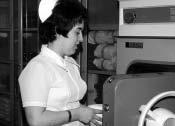
Dr.Jorge Guerrero,adjunct professor ofparasitology,has been recently appointed to the National External Advisory Committee ofthe College ofVeterinary Medicine ofthe University ofIllinois.
Dr.Ina Dobrinski was promoted to associate professor ofreproduction.She was invited to teach at the Woods Hole Course “Frontiers in Reproduction”and received the following grants:from NIH/NICHD for “Transgenic Goats Produced by Germ Cell Transplantation,”and from NIH/NCRR for “A Novel Approach to Germ-Line Preservation in Macaques.”
Dr.Fabio Del Piero,assistant professor of pathology, was the 2003 recipient of the Jurak Award for outstanding contribution to comparative pathology.Members ofthe European Society ofPathology and the Academy of Medical Sciences ofCroatia presented this award to Dr.Del Piero in recognition ofhis efforts to present and study diseases involving both humans and animals and to keep a link between veterinary and medical sciences.Dr. Del Piero has also become a member ofthe scientific committee for the Jurak Symposium of Comparative Pathology.
Mark Haskins,V’69,professor ofpathology and medical genetics,presented a talk at the Southwest Foundation for Biomedical Research,San Antonio,Texas,“Intravenous Retroviral Gene Therapy for Canine Mucopolysaccharidosis VII.”At the American Society for Gene Therapy,Washington,D.C.,he was chair and presenter at a workshop on “Genetic Diseases:Gene Therapy for Lysosomal Storage Diseases,”and was asked to host a Meet the Expert for Lunch session on “Gene Therapy for Lysosomal Storage Diseases Using Large Animal Models.”Haskins was appointed to a
Lindback Award for Distinguished Teaching
Dr.Kenneth Drobatz,associate professor ofcritical care medicine and director ofthe Emergency Service at the Ryan Veterinary Hospital,is a recipient ofthe Lindback Award for Distinguished Teaching.The recipients from all the schools in the University were honored during a ceremony in April.The Lindback Awards for Distinguished Teaching at the University of Pennsylvania were established in 1961 with the help ofthe Christian R.and Mary F. Lindback Foundation.Award winners are determined by nominations and recommendations made by faculty and students in December based on certain guidelines.Two separate committees,one in the Health Schools and one in the Non-Health Schools consisting ofsix previous award winners and four students,carefully decide among the nominees.
The Almanac published some ofthe comments in support ofKen Drobatz’s nomination: “Dr.Kenneth Drobatz joined the faculty ofthe Veterinary School in 1991.

three-year term as the Chair ofthe Scientific Advisory Board ofthe National Mucopolysaccharidosis Society.
Dr.Tracy Bale has joined the faculty as an assistant professor ofneuroscience.Her research interests are in the neuroendocrinology ofstress and the genetics ofstressrelated disorders including obesity and depression.
Dr.Alex Reiter,lecturer in dentistry,gave talks in April on feline dentistry and oral pathology at the University ofVeterinary Medicine, Vienna,Austria.In May he lectured in South Africa at Cape Town,Durban,and Pretoria, and in July at the World Veterinary Dental Congress in Kyoto,Japan.
Gail K.Smith,V’74,professor oforthopedic surgery, Tom Gregor, Dr.Pamela McKelvie,V’81, and Dr.Paster presented a PennHIP® training seminar affiliated with the AVMA meeting in Denver,the first PennHIP seminar on the road since PennHIP returned to Penn.Dr.Smith was an invited speaker in Birmingham,U.K.at both the British Small Animal Veterinary Association
He won the Resident’s Award for Outstanding Teaching in 1996,1999,and 2001,as well as The Norden Distinguished Teaching Award in 2002.He has consistently received the highest scores on course evaluations with one student writing that Dr.Drobatz’s class is outstanding despite being on Friday afternoon.Colleagues were equally enthusiastic about Dr.Drobatz’s teaching noting ‘Ken’s strength is that he regularly inspires his students;he gets his students to think logically and calmly about critical care.The enrollment for the elective courses he teaches is always close to 100% ofthe class—students want to be taught by him.It is to his credit that all ofour residents have passed the specialty-certifying exam,no small feat,as the pass rate is only 50-70%.’A former student writes:‘Dr.Drobatz is one ofthe best clinical instructors I have ever had.Over the past five years I have seen him head the emergency service,head the residency program, head the intern program and find the time to receive a master’s degree in statistics. Through his example he challenges his students to go one step further.He is indeed an outstanding candidate for the Lindback Award.’”
and the British Veterinary Orthopaedic Association in April 2003.
Dr.Eric Parente was promoted to associate professor ofsurgery.Parente, Dr.Christine Adreani,V’01,resident in surgery,and Dr.Dean Richardson, Charles W.Raker Professor of Surgery,were awarded a Firestone grant to investigate the benefits ofgene therapy to enhance reinnervation for treatment oflaryngeal hemiplegia.
BELL WETHER 57 9
Mary Ruth Hammond retired after 39 years of excellent service to New Bolton Center and the School.
School of Veterinary Medicine Teaching Awards

The Veterinary School’s teaching awards were presented during the annual Student Government Dinner Dance on April 26.This year,Philadelphia’s 30th Street Station provided the backdrop for an evening attended by 250 students,faculty,and staff.
Associate Dean






Jeffrey A.Wortman, V’69,standing in for the dean,presented the Dean’s Award for Leadership in the Basic Sciences to Dr.Olena Jacenko, associate professor ofphysiology;the Dean’s Award for Leadership in Clinical Science was presented to Dr.Billy Smith,assistant professor ofmedicine in New Bolton Center Field Service.Dr.Smith also received the Carl J. Norden Dinstinguished Teacher Award.
The two Dean’s Awards honor one faculty member from the clinical departments and one from the basic science departments who have made outstanding contributions to teaching their disciplines. The Norden Award was established in 1963 “to recognize outstanding teachers who, through their ability, dedication, character, and leadership,contribute significantly to the advancement ofthe profession.”
The four classes honored the faculty members they considered to be outstanding teachers.The Class of2003 presented awards to Dr. Corinne Sweeney, professor ofmedicine,and Dr.Kenneth
Drobatz,associate professor ofcritical care medicine.The Class of 2004 honored Raymond Sweeney,V’82, associate professor of medicine. Dr.James Lok, associate professor ofparasitology,received








the Class of2005 Award.The Class of2006 presented its award to Dr.Paul Orsini,director ofgross anatomy.
Cynthia R.Ward, V’87,assistant professor ofmedicine,was presented the Veterinary Medical Alumni Society Excellence in Teaching Award,which is presented annually,based on the recommendations ofrecent graduates;it is funded by the VMAS.



The Senior Class Resident Awards were presented to Dr.Ariel Mosenco,at the Ryan Veterinary Hospital,and Dr.Jennifer Smith, at the George D Widener Hospital.The Senior Class Intern Awards were presented to Dr. Vanessa Butler (Widener) and Dr. Stephen Mehler (Ryan). The class honored technicians Paula Emma (Ryan) and Emily Zug (Widener).
Other awards presented were:The Jules and Lucy Silver Award to Dr. Dan Fletcher (Ryan);the Interns’ Award to Dr. Steven Cole (Ryan); the Resident’s Award to Dr. Kenneth Drobatz;the Boucher Award to Dr. Sophy Jesty;the Harcum College
Technician Award to Eileen Rule (Widener) and Donna Sisak (Ryan);the Gretchen Swartz Award to Jennifer Wrigley;and the Senior Student Patient Care Awards to Charles Arensberg and Holly Connolly (Widener) and Jill Abraham and Meredith Daly (Ryan).
The Veterinary Medical Student Government honored Barbara Cavanaugh, librarian,and Dr.Corinne Sweeney
10 BELL WETHER 57
Barbara Cavanaugh
Dr.SophyJesty
Dr. Ariel Mosenco
Donna Sisak
Dr.Dan Fletcher
Dr.Steven Cole
Dr. Stephen Mehler
Emily Zug
Dr.Vanessa Butler
Paula Emma
Dr.Jennifer Smith
Dr.Ray Sweeney
Dr. Billy Smith
Dr.Jacenko
Dr.Corinne Sweeney
Dr. James Lok
Dr.Paul Orsini
Eileen Rule
New Social Worker at Ryan Hospital
Ms. Kathleen Dunn, the Ryan Veterinary Hospital’s chiefofsocial work retired at the end ofJuly.She came to the hospital in 1986 as a social worker and has helped countless clients get through difficult times.Over the years many letters from clients have expressed their gratitude to Kathleen for her help and many students,clinicians,and staffhave leaned on her as well.She has been particularly helpful in oncology and emergency services.The griefsupport group she founded is recognized as the first ofits kind in a university veterinary teaching hospital and has provided emotional support for clients ofRyan as well as for clients ofother veterinarians.
Jodi L.Levine has been appointed as the Ryan Veterinary Hospital’s new social worker. The social worker position has been restructured and much ofJodi’s duties will involve research,collaboration with other institutions, academic pursuits,working with Dr. James Serpell,associate professor ofhumane ethics and animal welfare,grant writing,and teaching.She will also be available to Ryan Veterinary Hospital clinicians when their clients are in need ofsocial work services.
Ms.Levine holds a Bachelor ofArts degree from American University and a Master of Social Work degree from Penn.She has worked as a social work internist at the David Lawrence Center in Naples,Florida and as a social work internist at Greater DC Cares in Washington, D.C. She served an internship here when enrolled in the University’s School ofSocial Work.She also served as an intern at Thomas Jefferson University Hospital in the Department ofFamily Practice.
Correction
In Bellwether 56 we reported that Brett Dolente,V’96, received funding from the Bernice Barbour Foundation and the AVMA Foundation. The AVMA Foundation was incorrect;the grant was from the ACVIM Foundation and the Barbour Foundation to begin a clinical trial using a novel heparin in horses with coagulothapies.
Coal CreekJoker:1982–2003
The School lost a devoted,loyal,hardworking member ofits family on May 19, 2003.Joker,one ofthree donated registered Morgan horses,who had been the linchpin ofthe carriage program at New Bolton Center,succumbed to colic at the age of21. Joker and his half-brother, Promise,have represented the School’s New Bolton Center at numerous prestigious events over the last six years. They have participated in drives at places as diverse as Saratoga Springs,N.Y., at the start of race season,the Devon Horse Show, Winterthur Steeplechase Races,and Ag Progress Days at Penn State.The team has done demonstrations for driving clubs and 4-H clubs,as well as a number ofother community outreach or
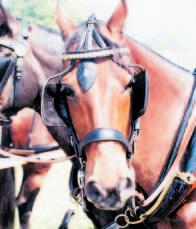
fundraising events.Joker was that once-in-alifetime horse—a perfect temperament,a noble work ethic,and a true “poster”horse for all that is best in the Morgan breed.
Everyone at New Bolton Center is deeply grateful to him for all his hard work, and extend sincere thanks to Mr. Art Glatfelter, who in 1997 generously donated Joker and Promise to the driving program,along with harness sets and a carriage.In 1999, he donated a third Morgan, Sammy,to the School.Through their efforts,the School’s carriage program reached new heights as an educational, public relations,and outreach tool.Joker will be greatly missed, his stall will be very difficult to fill,but his contribution to New Bolton Center will always be remembered.
The Second International Equine Conference on Laminitis and Diseases ofthe Foot will be held November 10 and 11, 2003 at the Breakers Resort in Palm Beach,Fla. The conference is organized by Dr.James Orsini,associate professor ofsurgery,and is supported by Mr.and Mrs. John K.Castle in loving memory oftheir horse,Spot.
The two-day program includes topics on diagnostic and therapeutic protocols,treatment options,pain management,nutritional considerations,and ethical concerns in the treatment of horses with laminitis.The program is open to veterinarians,who will receive continuing education credit,and owners,breeders and trainers who have their own breakout sessions.
The conference offers scientific presentations,and the world-renowned faculty will provide insight on the latest laminitis diagnostic and treatment options.A complete listing ofthe faculty and program can be found on the web at <www.slackinc.com/laminitis>.
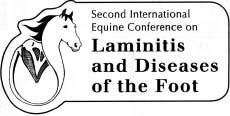
BELL WETHER 57 11
Winter thur 2002
Commencement 2003
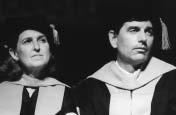
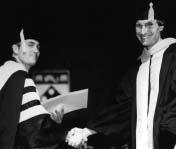
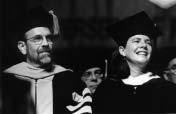
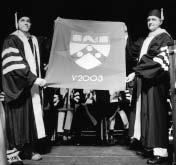
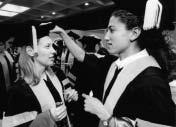
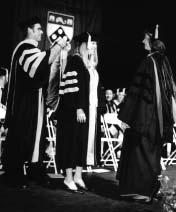
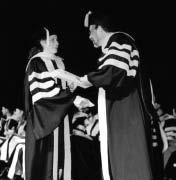
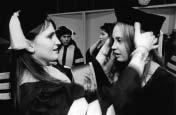
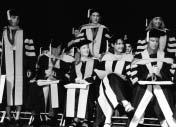
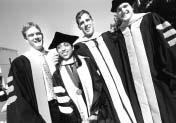
The Class of2003 brought the number of veterinarians who have graduated from Penn to 5,944.This year’s class of110 is composed of79 women and 31 men.
The 118th Commencement took place on May 19 at the Zellerbach Theatre on campus. Friends and families cheered as the graduating class walked on stage. Associate Dean Jeffrey A.Wortman,V’69, presided over the ceremonies for the Dean.The graduating class had requested two faculty speakers—Dr.Corrine R.Sweeney,professor ofmedicine,and Ray Sweeney,V’82,associate professor ofmedicine, who took this last opportunity to encourage their students to use the skills acquired at Penn and to leave their mark on the profession.
The presentation ofdiplomas and hooding is an emotional moment.This year Dr.Olena Jacenko,Dean’s Awardee for Leadership in Basic Science Education; Dr.Billy Smith,Carl J. Norden Distinguished Teacher Awardee and the Dean’s Awardee for Leadership in Clinical Science Education;and Deputy Associate Dean Charles D.Newton,did the honors.
Class President Jason Jon Cordeiro presented comments and received the Class Flag from James V.Stewart,V’68,president,Veterinary Medical Alumni Society.Associate Dean Wortman, assisted by Dr. Kenneth J. Drobatz, Lindback Distinguished Teacher Awardee, presented the prizes and senior awards. John L. Enck,Jr.,V’70, president ofthe Pennsylvania Veterinary Medical Association,administered the oath ofoffice.
After all the formalities were over,graduates and their families celebtrated on the plaza behind the Annenberg Center.
12 BELL
57
WETHER
Phot ogr aph y b y A ddison Gear y/addisongear y .c om
Corinne and Ray Sweeney
JasonCordeiro and James Stewart
Jeff Wortman and Christine Connelly,chair of the School’s Board of O verseers
Class of 2003
Jill Lauren Abraham**
Alison Joy Abramson
Victoria Weber Achenbach
Jennifer Anne Adler
Theresa Joseph Alenghat***
Charles Conrad Miller Arensberg*
Elizabeth Noel Ballard
Karen Marie Becker
Brett Edward Begley
Jeffrey Benjamin Bell
Lisa Hillary Bernstein
David Bessler
Kenneth Louis Bollens III
Todd Michael Brooks*
Kristin Kathleen Burton*
Gina Marie Cairone*
Nani Cha
Jessica Ann Chavkin***
Holly Lynn Shaginaw Connolly**
Jason Jon Cordeiro
Meredith Leigh Daly***
June Brenda Daniels
Mary Anna DuCray
Tony Luke Ebling
Rebecca Ann Elder
Ryan Lee Epple
Aubrey Kathryn Fitch
Stuart Lee Friedman
Rebecca Berjouhi Garabed
Award Recipients
Leonard Pearson Prize
Erik Steven Herrema
J.B.Lippincott Prize
Kimberly Anne Johnston
1930 Class Prize in Surgery
Kimberly Anne Johnston
Auxiliary to the American Veterinary Medical Association Prize
John Anthony Vinciguerra
Faculty/Student Chapter, AVMA Prize
Jeffrey Andrew Sachar
American Animal Hospital Association Award
Srinivas Lingareddy
American Association ofFeline Practitioners Award
Jessica Ann Chavkin
Sunny Geiser
Talia Glimer
Carrie Elizabeth Goldkamp**
Scott Joseph Goldman
Stephanie Elizabeth Graham
Daniel Jesse Hall
Alexander David Hamberg
Bridget Ann Hanley
Nathan Daniel Harvey
Lisa Perlman Harwood***
Jannette Lee Heere
Erik Steven Herrema
Kimberley Melissa Hershhorn
Amy Louise Hinze
Lexington Allen Hoffman
Sarah Colleen Holler
Sarah Jane Hoskins
Adonia Hsu
Amber Joelle Itle
Leah Carolyn Jackson
Keith Justin Javic
Kate Elizabeth Johnson
Kimberly Anne Johnston***
Jennifer Marie Jones
Karena Pey-Fen Joung
Karen Elizabeth Kemp
James J.Kim
Megan Kathleen King
Bradford Yaeger Kube
American College ofVeterinary Radiology Award
Erik Steven Herrema
American College ofVeterinary Surgeons Prizes
Small Animal Surgery Prize
Herbert William Maisenbacher III
Large Animal Surgery Prize
Kimberly Anne Johnston
Everingham Prize for Cardiology
Shannon Kerry Moriarty
Field Service Prize
Ross Landon Springer
The Peter Francis
Anatomy Award
Lisa Perlman Harwood
Hill’s Award
Leigh Ann Perry
Emily Kate Kupprion
Katharine Patricia Kurpel
Mary Theresa Kwacz**
Julia Susan Lane**
Amy Elizabeth Learn
Srinivas Lingareddy
Marybeth Rebecca Longo
P.Mark López
Herbert William Maisenbacher III***
Corinne Elise Majeska
Jill Kristen Maney
Betty Ann Marcucci
Jennifer Savage Matysczak
Joanne E.McCrea
Julie Louise McDade
Lisa Gwenn Meddock
Jessica Lauren Melman
Carrie Anne Miller
Elizabeth Kathryn Mills
Shannon Kerry Moriarty*
Courtney Elisabeth North
Sean Christopher Ott
Leigh Ann Perry
Christina Nicole Phillips
Natalie Pinchuk-Levitt
Darah Louise Resh
Rebecca Elizabeth Risbon
Linda Murray Ruiz
Anna Louise Russau
Iams/VECCS Award for Proficiency in Veterinary Emergency and Critical Care
Meredith Leigh Daly
James Hazlitt Jones Prize in Biochemistry
Lisa Perlman Harwood
Large Animal Medicine Prize
Christine Ashley Starer
Large Animal Surgery Prize
Charles Conrad Miller Arensberg
Merck Awards
Small Animal Award
Jill Lauren Abraham
Large Animal Award
Sarah Colleen Holler
1956 Class Medal for Achievement in Pathology
Jessica Ann Chavkin
George M. Palmer Prize
Sunny Geiser
Christopher Thomas Ryan***
Jeffrey Andrew Sachar
Krista Erika Schnabel
Anne Melissa Skope
Sarah Jeann Smith
Danielle Ann Springer
Ross Landon Springer
Christine Ashley Starer
Heather-Michelle Brooke Stewart
Lara Faith Sylvester
Stephanie Diane Szabo*
Kristen Ann Szydlowski
Jamie Beth Trauner
Christopher Shenwei Tsai
Charles Joseph Tucker
Katie Eileen Tuffey
Carrie Ellen Tupper
Krista Michele Vernaleken
John Anthony Vinciguerra*
Lauren Marie Wagman
Jeremy John Wentz
Sara Ann Woodberry
Keith Alan Zimmerman
Summa Cum Laude
Magna Cum Laude * Cum Laude
Pharmacia Animal Health Proficiency Awards
Companion Animal Award
Lisa Perlman Harwood
Equine Award
Charles Conrad
Miller Arensberg Food Animal Award
Nathan Daniel Harvey
Charles F.Reid Sports Medicine and Imaging Award
Kimberly Anne Johnston
Lynn Sammons
Food Animal Award
Tony Luke Ebling
Morris L.Ziskind Prize in Food Animal Medicine
Amber Joelle Itle
Morris L.Ziskind Prize in Public Health
Meredith Leigh Daly
BELL WETHER 57 13
***
**
Racetrack Veterinarian to VMAS President:The Purse Goes to Penn
by Joan Capuzzi Giresi,C’86 V’98
When it comes to tapping into his clinical instincts,to thinking through a case,Penn gave racetrack veterinarian James V.Stewart,V’68, the inside track.In return,Stewart,the new Veterinary Medical Alumni Society (VMAS) president,has given Penn his steadfast devotion.
He hopes his loyalty will be contagious:“It’s part ofmy job to pass this spirit on,”says Stewart,who began his two-year term in May.
Stewart credits Penn for helping him develop his medical intuition.Stewart recalls William B.Boucher,V’40,professor of medicine,who told him,“You only see what you look for and that looking involves using all ofyour senses.”
Stewart ticks offseveral examples:the infections that can be diagnosed—by smell alone— the moment you enter a stall.The numerous orthopedic lesions he has characterized without an x-ray.The many tentative diagnoses he has made—and proven correct—in contradiction to what a client had insisted was the malady.
“Ifyou take a thorough history and use your eyes, ears, and hands well enough,you can figure out what is going on,”Stewart maintains. “It’s very easy as a veterinarian to have your clients direct you,” he says.“You have to direct them…. You can do this best when you know the case better than the owner does.”
Stewart himselfneeded little direction in finding his equine calling.It would seem like destiny:His father emigrated here from Ireland by stowing away with a load ofhorses,and eventually became a horse trainer.His mother was one of the first women licensed to train racehorses in this country.The two met through the industry,married,and raised Jim on a sprawling Thoroughbred farm in Elkton, Md.Stewart’s maternal grandfather had a livestock farm adjacent to his parents’spread, which was among the first breeding facilities in Cecil County,Md.,now a hub for racehorse breeding.
An only child,Stewart was a constant hand on the farm.With his father out oftown training for much ofthe year,he did everything from muck stalls to foal-watch in springtime. His mother,whom he respected and adored, had a keen intuition about animals,from the ever-present Chesapeake Bay retrievers the family kept on the farm for hunting and as
pets,to horses.“You didn’t even bother arguing with her about what she thought the horses were thinking,”Stewart chuckles.“She was always right.”
Although he was surrounded by veterinarians both on the farm and at the track,Stewart never aspired to become one.“My expectations weren’t high enough to seek that,”he says.“But I always knew I was going to work with horses. There was no question about that.”
Stewart figured he would run a breeding farm or become a trainer.Although he was a good student at Archmere Academy,a top prep school near Wilmington,Del.,he had no plans to attend college.When he shared his career plans to a high-ranking racing official he knew, the older man encouraged him to pursue veterinary medicine.
After that talk, Stewart began to see his world differently. He enrolled at the University ofMaryland,where he took his pre-vet courses through the College ofAgriculture.His advisor there suggested he take the agriculture courses that were required at the time by many veterinary schools. He refused,since they were not required by Penn, which was the only school to which he intended to apply.
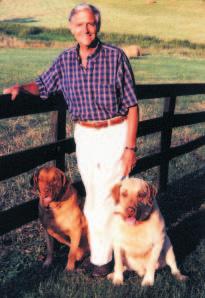
“Every veterinarian I knew who was terrific went to Penn,” says Stewart, who was acquainted with many icons in the fields ofequine reproduction and general medicine.
One ofjust a handful ofstudents in his class accepted after only two years ofcollege,Stewart had to play “catch-up”in courses like physiology,histology,and embryology,which his fellow students had already taken at the undergraduate level. But that wasn’t his only obstacle:His father died suddenly in February ofhis first
year,leaving him to shoulder a lot ofthe responsibility at home.Well on his way to flunking out ofschool,he eventually told his mother he had to stop coming home on weekends to work on the farm.
Stewart remembers his clinical years with fondness.Although he never faltered in his desire to enter the field ofequine medicine,he acknowledges having acquired many ofhis fundamental skills,particularly in fields like surgery and anesthesia,by working with small animals during school.“I had a great appreciation for small animals,and still do,”says Stewart,who,along with his wife,small-animal veterinarian Brenda Lewis Stewart,V’70,breeds and shows American Kennel Club champion Chesapeake Bay retrievers.
Following graduation,Stewart stayed at Penn for an internship and a residency in large animal surgery.He remains effusively grateful for the first-rate training he received from faculty members with whom he worked closely at New Bolton Center,such as Dr.Boucher, Dr.Jacques Jenny, professor oforthopedic surgery,and, in particular, Charles W.Raker, C’41 V’42, Lawrence Baker Sheppard Professor ofSurgery.
Of the Penn faculty,he wistfully recalls,“They were absolutely great,selfless, giving teachers with complete devotion to what they were doing.They were individuals who epitomized how people should be and how they should treat other people and animals. And they passed that on to the students and residents.”
After his residency,Stewart joined a
(continued on page 18)
V.M.D.NotesV.M.D.NotesV.M.D.NotesV.M.D.NotesV.M.D.Notes V.M.D.NOTESV.M.D.NOTESV.M.D.NOTESV.M.D.NOTESV.M.D.NOTESV.M.D.NOTES 14 BELL WETHER 57
Dr.Stewart with two of his beloved Chesapeake Bay retrievers, Red and Cal.
Bettering the Lot of Israel’s Animals
by Joan Capuzzi Giresi,C’86 V’98
Dog fights,snake bites, Leishmania, and Spirocerca lupi.Not exactly day-fillers for the typical companion-animal practitioner.Unless, ofcourse,you’re Sarah M.Levine,V’94, who sees her share ofsuch domestic scarcities while practicing veterinary medicine in Israel.
“Working in a foreign country exposes you to many diseases you learn about in school but don’t necessarily see,”says Levine, who moved to Israel 31/2 years ago.
Levine ministers to Israel’s dogs and cats— both owned and stray— through Concern for Helping Animals in Israel (CHAI), a nonprofit organization focused on improving the lot ofIsrael’s animals.As sole veterinarian for CHAI Israel, Levine navigates a mobile clinic through Israel, providing low-cost medical care for pets and spaying/neutering strays rounded up by municipal veterinarians and townspeople.
Among CHAI Israel’s most vexing challenges is harnessing the stray-cat overpopulation,which,Levine laments,“is part ofthe landscape in Israel.”
Levine also speaks at schools and community centers about the importance ofveterinary care and empathy for animals,who,she says, have been somewhat neglected as a result of local cultural mores.
Because leash laws are largely ignored there and animals are allowed to roam free,Levine sees more than her share oftrauma cases and cats sickened by FIV,which she says has infected approximately 30% ofIsrael’s outdoor cats.
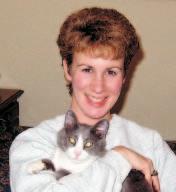
Furthermore,says Levine,quality preventive care is not the rule in Israel,where many owners turn to hormone therapy to block heat cycles rather than spay/neuter their pets.This widespread reluctance to pursue well care transcends wealth and education:Levine recalls working in one ofIsrael’s most elite neighborhoods and meeting resistance to routine vaccination from pet owners,many ofthem highranking diplomats.
“Ifyou’re practicing veterinary medicine here,”she explains,“you take a lot for granted in terms ofowner knowledge.For instance, they have no concept ofthe fact that their pets’ intestinal parasites can be transmitted to their family.”
Levine’s upbringing was far more enlightened about animals and science. Growing up in Pittsburgh,she and her six siblings gained an early understanding of clinical medicine from their father,an ear, nose,and throat doctor who made learning fun for his children.
“We knew the 12 cranial nerves when we were kids,”she recalls with a chuckle.“My father would say, ‘The 10th nerve is the vagus nerve.It helps you swallow even when you’re upside-down.’Then he would bring us into the living room and have us stand on our heads and eat food to prove to us that the vagus nerve worked.”
Although her father,who held mock medical rounds with his clan at the dinner table each night,encouraged Sarah to go into human medicine,a veterinary career was a foregone conclusion for her.“I always loved animals and had a nice way with them,”says Levine,34,whose childhood home was filled with pets.“We would go to the petting zoo and all the animals would come to me.”
An English literature major at Stern College for Women (part ofYeshiva University) in New York City,Levine fulfilled her science requirements on the side and became the first Stern graduate to go to veterinary school.Accepted to two other schools,she chose Penn for its fine reputation and its proximity to her grandmother and aunt,who lived in Philadelphia.
Following school,Levine spent a few years in small-animal practice in central New Jersey. When her husband, an attorney working in the
venture-capital industry,was offered a job in Israel,they eagerly relocated there in early 2000.
After settling her three young daughters into their new home in Ra’anana,a suburb just north ofTel Aviv,Levine hit the books in preparation for Israel’s veterinary boards.An orthodox Jew with a Zionist upbringing, Levine was amply schooled in Hebrew and even had spent a year in Israel during college. But while drilling for the national boards, which were not offered in English,she realized that Hebrew was as much as second language for her as was large-animal medicine.She still cringes when she remembers “studying blue tongue and all those other large-animal diseases in Hebrew.”
Although many veterinarians in Israel are unemployed due to oversupply,Levine says her Penn education made her a favorable job candidate.In her early days ofsmall-animal practice in Israel,her Hebrew—which has since improved—was still a slight hindrance.“I could sound like the doctor ifI was explaining diabetes in English.But in Hebrew…,”she trails off.
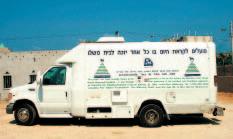
The language barrier was not Levine’s only hurdle.“It’s still a challenge to mesh culturally. Here,it’s important to be very subtle,gentle, diplomatic and not come offas superior.You have to lead [clients] into thinking that something was their idea.”
Levine,who keeps current on her continuing-education requirements in the States,also has had to familiarize herselfwith an entirely different cache ofanimal afflictions from what she was accustomed to seeing in the U.S.(She also has had to bid adieu to some,such as heartworm and endocrine diseases,which she
(continued on page 24)
V.M.D.NotesV.M.D.NotesV.M.D.NotesV.M.D.NotesV.M.D.Notes V.M.D.NOTESV.M.D.NOTESV.M.D.NOTESV.M.D.NOTESV.M.D.NOTESV.M.D.NOTES BELL WETHER 57 15
Class Notes
1956
Elizabeth A. Lawrence, professor emerita at Tufts University School ofVeterinary Medicine,was quoted in the article,“Cute but Wild:The Perilous Lure ofExotic Pets,”which appeared in the June 24,2003, edition of The New York Times.According to Dr. Lawrence,people are drawn to owning exotic pets because “They value the wild animal because it is less subservient,because it is unpredictable and won’t take orders.The owners also often want to prove that they have power over it and to shock people.”Dr. James A.Serpell,Marie A.Moore Associate Professor ofHumane Ethics and Animal Welfare and director ofthe Center for the Interaction ofAnimals and Society at Penn Veterinary Medicine,was also quoted in the article.
Paul J.Suorsa was recently honored with the 2002 Bullshipper Award from the Butler County,Pa.,Rotary Club for serving his community for 46 years as a veterinarian.The award is presented annually to the person who excels in promoting farm-city relations in and around Butler County.Dr.Suorsa co-owns Slippery Rock Veterinary Hospital with his son, Daniel,V’92.
1963
Katherine A. Houpt, professor ofphysiology at Cornell University College ofVeterinary Medicine, was quoted in the article,“What Makes a Winner?” which appeared in the May 12,2003,edition of The Baltimore Sun.In the article,which discusses whether horses have “gameness”or a desire to win, Dr.Houpt says that to spot the dominant horse at the starting gate,“He’ll ‘stand up tall and lean toward the other horses.He may threaten them by pinning his ears back.He may have his mouth open trying to bite.’” Dr. Sue McDonnell,the founding head ofThe Havemeyer Equine Behavior Program at New Bolton Center,was also quoted in the article.
1972
Lawrence T.Glickman,professor ofepidemiology and environmental health and section head ofClinical Epidemiology at Purdue University School of Veterinary Medicine,was honored with the American Kennel Club Excellence in Research Award during the American Veterinary Medical Association Annual Convention in July 2003.Dr.Glickman was selected for his impressive research on Gastric Dilatation-Volvulus and his innovative approaches to various canine diseases.
1973
Robert M. Bowker, associate professor ofpathobiology and diagnostic investigation at Michigan
State University College ofVeterinary Medicine,was honored in April 2003 with the Carl J.Norden Distinguished Teacher Award.The award was given in recognition ofhis outstanding teaching ability,leadership,and high moral character.
Midge Leitch visited the School ofVeterinary Medicine and spoke to students in April 2003 as part ofthe Dean’s Alumni Career Speaker Series.She owns Londonderry Equine Clinic,a referral veterinary practice in Cochranville,Pa.,where she specializes in the care ofperformance horses competing in dressage,driving,eventing,and jumping.Dr.Leitch is a member ofthe USA Equestrian Veterinary Committee and has served as team veterinarian at the last three consecutive Olympic Games and many other national and international events,including the World Equestrian Games.
1974
Leslie A.Dierauf has been appointed director of the National Wildlife Health Center (NWHC) in Madison,Wis.,one of18 science centers ofthe Biological Resources Discipline ofthe U.S.Geological Survey,a bureau ofthe U.S.Department ofthe Interior. The mission of the NWHC is to provide information, technical assistance,and research on national and international wildlife health issues.According to Dr.Dierauf,“The position as NWHC Director will provide me the opportunity to take the scientific expertise at the NWHC and shape a program that will promote effective,credible,and timely scientific research about our nation’s wildlife,helping not only species and habitats,but also presenting valuable
Oradell Animal Hospital Opens New Facility
Paul C.Gambardella,V’72, director of Oradell Animal Hospital in Paramus,N.J.,was interviewed about Oradell’s new $12 million, 36,000-square-foot hospital in the June 1,2003, edition of The New York Times.According to the hospital’s founders,including William S. Stockman,V’66, who remains on staffas a consultant,the new facility will be the country’s largest privately held veterinary practice.Alumni who practice at Oradell (as ofAugust 2003 according to its website) include: Rita Angelo, V’91; Joyce K.Cohen,V’02; Edytheann DeMaria, V’98; Jamison DeSantis, V’00; June S.Hacker,V’95; Megan E.Julian,V’02; and William F.Lucker,Jr.,V’66
information for decision-making throughout the Department ofthe Interior.”
1977
Sydney M.Evans,associate professor ofradiation oncology in the Penn School ofMedicine,was a visiting professor in June 2003 in the Department of Neurosurgery at the M.D.Anderson Cancer Center in Houston.She presented a talk entitled “The Prognostic Importance ofHypoxia in Brain Tumors.”Dr. Evans was invited to serve as a member ofthe Radiation Study Section ofthe National Institutes of Health Center for Scientific Review.She will help review applications dealing with the interaction of radiation and heat with matter at the molecular, cellular,and clinical levels.
Christian E.Newcomer has been appointed The Johns Hopkins University’s first associate provost for animal research and resources,responsible for university-wide planning and other issues relating to research using animal subjects.He will serve as an advisor and frequent consultant to the university’s Institutional Animal Care and Use Committee,a group that reviews all animal research protocols to ensure that use of animal subjects is essential and that any pain or discomfort to animals is minimized. According to Dr.Newcomer,“There are just an incredible number ofissues that come up in a big and vibrant animal research program like Johns Hopkins’.I will work to determine how we keep a step ahead ofwhere the science is going,and how we do that the right way.”
1981
Yvette M.Davis is a scientific review administrator at the National Institutes ofHealth and is a commander in the U.S.Public Health Service Commissioned Corps.
1987
Gary M. Tabor is a program officer for the Wilburforce Foundation,a private,philanthropic foundation that funds environmental issues in the western U.S.and western Canada,and is responsible for grantmaking in the Yellowstone to Yukon region.
Dr.Tabor is also the co-editor of Conservation Medicine: Ecological Health in Practice, the product of a 1999 conference ofthe Consortium for Conservation Medicine,where he served as the founding executive director.The Consortium is a unique collaborative institution that strives to understand the link among anthropogenic environmental change,the health ofall species,and the conservation of biodiversity.
16 BELL WETHER 57 V.M.D.NotesV.M.D.NotesV.M.D.NotesV.M.D.NotesV.M.D.Notes V.M.D.NOTESV.M.D.NOTESV.M.D.NOTESV.M.D.NOTESV.M.D.NOTESV.M.D.NOTES
1989
Paula M.Colletti has become board-certified in canine/feline practice by the American Board ofVeterinary Practitioners.
Karen Lavinia Johnston is a product manager for Nestlé Purina PetCare in Australia.In June 2003,she and her husband visited her family in the Philadelphia area and the Ryan Veterinary Hospital at Penn before attending the American College ofVeterinary Internal Medicine Forum in Charlotte.
1990
Major Joseph G.Williamson was featured in the article,“A Tour in the Desert:Veterinarians Fill Forward Positions in Iraq Campaign,”which appeared in the May 15,2003,issue ofthe Journal of the American Veterinary Medical Association.Major Williamson served in Operation Iraqi Freedom,and he and his team were responsible for food safety inspections by performing sanitary audits ofmore than a hundred commercial facilities or suppliers in 10 countries to the coalition forces.
1994
Michele L. Hurst married David Paul on January 11, 2003.
1996
Katherine B.Chope and Jose M. Garcia-Lopez are now working at Tufts University School ofVeterinary Medicine.Dr.Chope provides a three-days-a-week ultrasound specialty service for large animals,covering all ofthe major body systems,with a special interest in equine musculoskeletal injuries and cardiology Dr.Garcia-Lopez is an assistant professor of large animal surgery,and his surgical interests include equine orthopedics and upper airway disorders,including the use oflasers.Drs.Chope and Garcia-Lopez have two children,Jose Maria and Katerina Amelia.
1997
Michael N.Fugaro has become board-certified by the American College ofVeterinary Surgeons. Michelle G.Hawkins has become board-certified in avian practice by the American Board ofVeterinary Practitioners.
1999
Dana Frederick is director ofveterinary services for Labrador Service Dogs,a national organization that trains Labrador retrievers to assist people who are confined to wheelchairs.
2000
Jason W.Brooks has joined the staffofthe Animal Diagnostic Laboratory at The Pennsylvania State University.He will divide his time between service in field investigation and necropsy.
Jacob R.Werner is the attending veterinarian for agricultural animals and wildlife at The Pennsylvania State University.
2002
Edward S.Cooper,an intern in the Department ofSmall Animal Clinical Sciences at Michigan State University College ofVeterinary Medicine,was honored in April 2003 with the SCAVMA Intern Award. The award was given in recognition ofhis outstanding performance in the clinical training and teaching ofstudents.
Tracy A.Filler was interviewed in the article,“Caring for Pets,”which appeared in the June 26,2003, issue ofthe Casco Bay Weekly ofPortland,Maine. According to Dr.Filler,who lived in Pennsylvania her entire life, she chose to practice in Maine because she “loved New England and dreamed ofseeing Acadia National Park.”She added,“I wanted to be where the outdoors could be enjoyed.I wanted to hike,drive,and explore along the coast.I looked forward to a slower pace oflife and people who are open and friendly.”
2003
Nathan D. Harvey is serving as the dairy production medicine intern at New Bolton Center.
Births
1978
Gregory D.Bossart,a daughter,Ansley Claire Bossart,on May 13,2003.
1995
Kristen M.Lohr-Yucha,a son,Alexander David, on February 20,2003.
Deaths
1931
Herbert F.Harms,Jr. on May 27,2001.
1934
George E.Outwater on January 21,2002.
1936
Frank G.Dubuy on April 10,2003.
1939
Ralph C. Fish,Jr. on March 7,2002.
1940
Clyde I.Boyer,Jr. on April 12,2003.
1941
Herbert S.Rachlin on July 10,2001.
1946
Rodney S.Billett on October 24,1998.
1947
Russell A.Nelson on May 4,2003.
1951
Jacob Levenson on December 15,2002.
1952
Frank A.Bartus on April 21,2003.Father of Michelle C.Bartus,V’84,and father-in-law ofPeter D.Nelson,V’84.
1960
Payson J.Brett,Jr. on January 2,2003.
1962
Paul Berg on August 18,2003.From 1966 to 1972,Dr.Berg was a member ofPenn Veterinary Medicine’s faculty as an assistant professor then as an associate professor ofsurgery.In addition to his private practice,Dr.Berg returned to the School in 1980 and served for many years as an adjunct professor of surgery Father of Melissa J.Berg,V’96.
1971
George A.Franklin,Jr. on April 27,2002.
1994
Elizabeth Stewart Claffey on April 15,2003.
Share news with your classmates about a new position or accomplishment,wedding,or birth announcement by sending your class note today! We accept pictures,too,featuring alumni gatherings,whether it’s from a wedding or minireunion.Be sure to identify everyone in the picture. Pictures will be returned only upon request. Send all your submissions to:
Joshua E.Liss
Director ofAlumni Relations & Annual Giving
University ofPennsylvania
School ofVeterinary Medicine
3800 Spruce Street
Philadelphia,PA 19104-6047
Fax (215) 573-3544
E-mail lissj@vet.upenn.edu
BELL WETHER 57 17
V.M.D.NotesV.M.D.NotesV.M.D.NotesV.M.D.NotesV.M.D.Notes V.M.D.NOTESV.M.D.NOTESV.M.D.NOTESV.M.D.NOTESV.M.D.NOTESV.M.D.NOTES
Racetrack Veterinarian to VMASPresident
(continued from page 14)
racetrack practice in Laurel,Md.,where he remains today as a partner.The seven-doctor practice,since renamed Yergey,Stewart, Vallance and Associates,covers all the tracks in Maryland and one in Virginia.Although his hours are excruciating—on the track by 5:00 in the morning for training and sometimes there through dinnertime,after the last race has ended—Stewart,59,prefers track work to anything else.
“Racehorses are nicer to deal with than someone’s spoiled riding horse,”he declares.
He is less complimentary ofsome ofthe people in the industry.Racing,says Stewart, who holds an appointment to the Grayson Research Jockey Club Foundation,which funds research in equine medicine and surgery,has suffered from “the desire ofa small-but-significant group to beat the system”with banned performance enhancers like sodium bicarbonate “milkshakes”and analgesics.
For the racing industry,Stewart hopes a more enlightened attitude about which medications and supplements should and should not be permissible will one day prevail.He also wants to see meatier purses so that,in the future,the horses might be housed in healthier accommodations offering better ventilation and sanitation.
For the sphere ofequine medicine,Stewart’s wish is far more modest—that people will continue to enter the field.Because ofthe demanding lifestyle and lean salaries,horse medicine is losing warm bodies.In fact,Stewart’s own practice has difficulty recruiting veterinarians.
As VMAS president,Stewart wants to boost alumni involvement in the Opportunity Scholarship Program,a scholarship-mentorship program that pairs alumni donors with recipient students.He notes that many patrons have found the program,which graduated its first class in 2002,personally rewarding and a great opportunity to interact and gain understanding ofthe problems and goals ofnew graduates.
In order to update the School community on the proceedings ofthe VMAS Executive Board, Stewart will pen a President’s Letter in each issue of Bellwether.
“I want to let people know they can play a role,make a contribution,and get satisfaction out ofit,”says Stewart,who,along with wife Brenda,has been an Executive Board member
for much ofthe past decade.
This sentiment,he says,also extends to the students,from whom he hopes to stir greater VMAS participation.Among Stewart’s goals is to arrange productive interaction and information exchanges as outreach efforts geared toward instilling students with a stronger sense ofdedication to the School.
“The students really have no idea what the School does for them,getting them scholarship money,working with the state legislature to defer their costs…,”he explains.
AlumniConnections
To find a former classmate and to sign up for a permanent e-mail forwarding service: Join the University ofPennsylvania Alumni OnLine Community for free at <www.alumni connections.com/olc/pub/UPN>.After you register,you can search the On-Line Directory,which is a great resource for personal and professional networking and an easy way to keep up-to-date on fellow alumni.You can also sign up for a permanent e-mail forwarding service,which will forward messages received at your permanent Penn address to the e-mail address ofyour choice.
To update your alumni record: You can update your record via the University of Pennsylvania Alumni On-Line Community OnLine Directory.You may also contact Elizabeth McNamara at (215) 746-7461 or via e-mail at <emcnamar@vet.upenn.edu>.
To make a gift or for information to support Penn Veterinary Medicine: Make a gift with your credit card through a secure online transaction at <www.upenn.edu/gifts>.For information on supporting the School,visit the Alumni & Friends website at <http://alumni.vet. upenn.edu> or contact Joshua E.Liss at (215) 898-1481 or via e-mail at <lissj@vet.upenn.edu>.
To request a transcript,certification of graduation, or replacement diploma: For information on requesting a transcript,visit the Office ofthe University Registrar’s website at <www.upenn.edu/registrar/transcripts/ transcripts.html> or call (215) 898-7511.For information on requesting a certification ofgraduation,which does not require a transcript,contact the School’s Office ofStudent & Curricular Affairs at (215) 898-3525 or via e-mail at <student-affairs@vet.upenn.edu>.For information on ordering a replacement diploma,visit the Office ofthe Secretary’s website at <www.upenn. edu/secretary/diplomas/#diplomas>.
To post/search employment opportunities for veterinarians: Visit the School’s Veterinary Employment Database at <www.vet.upenn.edu/jobsearch>.
Stewart also aims to incorporate both past and future graduates ofthe internship and residency programs,who do hold alumni status, into the Penn community once they leave.
OfStewart’s hefty sense ofcommitment to the School,outgoing president Eric M. Bregman,V’95,says,“Jimmy is probably one of the most motivated alumni that I know,one of the School’s finest boosters.”
To this,Stewart would probably reflect on his Penn education and say that he’s just returning the favor.
To purchase veterinary,medical,and alllied health textbooks from leading publishers: Visit the Penn Vet Bookstore at <www.vet.upenn. edu/studentaffairs/bookstore>.A percentage of purchases is returned to the School in the form of scholarship funding to deserving veterinary students.
To obtain a Penn Alumni Card:
The Penn Alumni Card offers a myriad ofbenefits,including access to the Penn Libraries (does not include borrowing privileges or access to online resources) and discounts on admission to the Morris Arboretum,Class of1923 Ice Rink, and University ofPennsylvania Museum.The charge for the card,which is valid for 10 years,is only $20.For more information,visit <www. upenn.edu/penncard/card/obtain_alumni.html>.
Alumni Relations and Annual Giving Staff
Joshua E. Liss
Director ofAlumni Relations and Annual Giving
(215) 898-1481
Fax (215) 573-3544
E-mail <lissj@vet.upenn.edu>
Elizabeth McNamara
Annual Giving Coordinator
(215) 746-7461
Fax (215) 573-3544
E-mail <emcnamar@vet.upenn.edu>
Please address any correspondence to:
Office ofDevelopment and Alumni Relations
University ofPennsylvania
School ofVeterinary Medicine
3800 Spruce Street
Philadelphia,PA 19104-6047
V.M.D.NotesV.M.D.NotesV.M.D.NotesV.M.D.NotesV.M.D.Notes V.M.D.NOTESV.M.D.NOTESV.M.D.NOTESV.M.D.NOTESV.M.D.NOTESV.M.D.NOTES 18 BELL WETHER 57
AStrong Advocate for LaboratoryAnimal Medicine
by Susan I.Finkelstein
Over the course ofhis distinguished career, Hilton J.Klein,V’80,has accomplished much in the fields ofcritical research and human and animal drug and vaccine discovery and development.During its Annual Convention in July 2003,the American Veterinary Medical Association recognized Klein’s contributions to the field oflaboratory animal science by honoring him with the Charles River Prize,which is awarded by the Charles River Foundation.
Currently the senior director ofcomparative medicine and director ofthe Department ofLaboratory Animal Resources for Merck Research Laboratories in West Point,Pa.,Klein provides strategic planning and direction for Merck’s animal care and use programs and is the lead auditor for all animal care programs for Merck worldwide.As Merck’s representative,Klein also played an important part in establishing a conservation program for neotropical primates in collaboration with the Pan American Health Organization.
Klein credits his education at Penn’s Veterinary School,with its emphasis on basic science,for pointing him in the direction ofa research career.In fact,Klein notes,because of Penn’s continued research-focused curriculum, “Penn graduates are better equipped than ever before to understand what’s going on in research.”In 1977,as the very first Penn student to participate in the Merck Summer Research Fellowship Program,where he was mentored by two laboratory animal veterinarians,Klein found his initial desire to practice large animal medicine gradually giving way to a growing interest in research.
After graduating from Penn in 1980,“an opportunity to do research on human infectious diseases presented itself,”recalls Klein.As manager ofveterinary sciences at Whitaker M.A.Bioproducts in Walkersville,Md.,Klein, in addition to his duties as clinical veterinarian and laboratory animal care supervisor,helped research and develop diagnostic tests for infectious animal diseases,including ELISA (Enzyme-Linked ImmunoSorbent Assay),a fundamental tool ofclinical immunology used as an initial screen for HIV detection,and the FA (Fluorescent Antibody) Test,which for many years has been used to detect influenza virus infection in frozen sections oflung.His comparative infectious disease research
encompassed toxoplasmosis,herpes,and cytomegalovirus.
In 1985,Klein joined Merck Research Laboratories as a staffveterinarian,where he collaborated with researchers in developing animal models to establish “proofofconcept” and safety for human medicines and vaccines. During his 18 years at Merck,the number of animals has more than and the professional stafftripled.
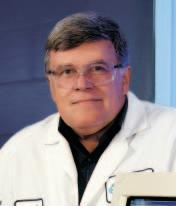
Klein was recently honored with Merck’s
are available for veterinarians to enter the research arena.Klein states,“We as veterinarians shouldn’t consider research as an ‘alternative’career;it’s a good primary career that offers lots ofopportunities for vets—in agricultural research,biomedical research, human medicine research—for which Penn graduates are uniquely qualified.”
Research veterinarians can help shape animal welfare policies and practices at the local, national,and global levels.Klein has worked with international agencies like the World Health Organization,regulatory agencies like the United States Department ofAgriculture, accrediting agencies like the Association for Assessment and Accreditation ofLaboratory Animal Care–International (where he served as president ofits Council on Accreditation),and professional/scientific groups like ILAR.He has traveled extensively throughout the world— including places as diverse as Canada,Italy, France, the Philippines,Taiwan,and Cuba, where he actually met Fidel Castro.At each stop,no matter how distant or unfamiliar,the common thread was always animals and research.
2002 Animal Alternatives Award,along with Thomas E.Nolan,D.V.M.,recently retired from Merck’s Department ofLaboratory Animal Resources.The award recognizes Merck employees worldwide whose research and published work support the animal-alternatives concept of“3 Rs”—replacing,reducing,or refining animal models used in laboratory research. Klein and Nolan’s award-winning paper,“Methods in Vascular Infusion Biotechnology in Research with Rodents,”appeared in 2002 in the ILAR Journal,the publication of the Institute for Laboratory Animal Research. The paper describes innovative techniques (with animal welfare in mind) that use miniaturized animal models to facilitate drug discovery and development.This novel technology is now being used in Merck research areas— including obesity,diabetes,cancer,and vaccines—and will ultimately benefit both human and animal health.
Because veterinarians trained to conduct basic biomedical research are in short supply across the country,many career opportunities
Klein points to the emerging field of“translational medicine”as another type ofresearch career available to graduates.Knowledge and technology are being improved today at an increasing pace—and with them,our desire to see a rapid progression,or “translation,”of information from laboratory to hospital,from theoretical to practical.This desire generates the need for a whole new range oftrained professionals to perform the critical task ofmoving medical research closer to commercially ready medical technology.Animals play an integral part in the two main steps ofthis “bench-to-bedside”research (first proving a concept,and then ensuring its safety)—and where there are laboratory animals,ofcourse, there is a need for veterinarians.“This is a chance to help both humans and animals by developing drugs and vaccines,”states Klein.
An adjunct associate professor oflaboratory animal medicine at Penn,the author or coauthor ofmore than 30 scientific articles, and a diplomate ofthe American College of Laboratory Animal Medicine,Klein is uniquely qualified to serve as an advocate for a field that strives to advance the health and welfare of humans and animals.
V.M.D.NotesV.M.D.NotesV.M.D.NotesV.M.D.NotesV.M.D.Notes V.M.D.NOTESV.M.D.NOTESV.M.D.NOTESV.M.D.NOTESV.M.D.NOTESV.M.D.NOTES BELL WETHER 57 19
AlumniWeekend 2003
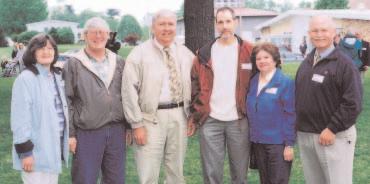
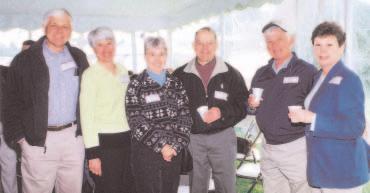
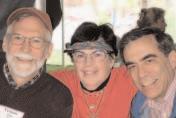
On Saturday,May 17,more than 250 alumni and their guests enjoyed a variety of Alumni Weekend 2003 events at New Bolton Center.Along with the Alumni Picnic and tours ofNew Bolton Center during the day, more than 125 alumni and their guests attended a reception and dinner at the Brandywine River Museum in Chadds Ford,Pa.
More than 50 members ofthe Class of1978 and their guests attended a separate dinner that same evening at the Sheraton Society Hill Hotel in Philadelphia,where they celebrated raising more than $100,000 in gifts and pledges to establish the Class of1978 Endowed Scholarship Fund.
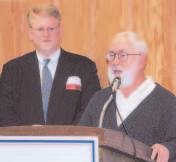
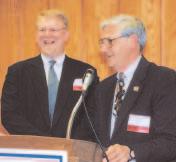
Cynthia R.Ward,V’87,assistant professor of medicine at the Ryan Veterinary Hospital at Penn, receives the 2003 Excellence in Teaching Award from Eric M.Bregman,V’95,Veterinary Medical Alumni S ociety President, and Daniel D.Bleicher, V’53.The VMAS presents this annual award to an educ ator recommended by recent graduates. (JR)
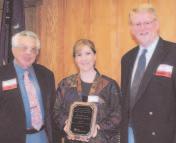
20 BELL WETHER 57
Alumni Weekend 2003 photography by Jim Roese (JR) and Candace diCarlo (CD).
Class of 1973:Vernon R.Durie,Dorothy J.Miller,and Randall C.Fertelmes.Photo courtesy of Vernon R. Durie.
Class of 1963:Eugene Witiak,Joan F.Witiak,Martha S.Wenger,Melvyn G.Wenger,Donald W.Merryman,and Joy Merryman. (JR)
Class of 1968:Cathy Shields,James B.Shields,H.Wesley Towers,Jr.,Kenneth G.Kagan,Carolyn J.Stokes,and Kenton S.Stokes. (JR)
Eric M.Bregman,V’95,shares a laugh with James V. Stewart,V’68,after Dr.Stewart is introduced as the new VMAS president. (JR)
John O.Mason,V’53,speaks on behalf of the Class of 1953 before the awarding of the Fiftieth Year Reunion Certificates. (JR)
V.M.D.NotesV.M.D.NotesV.M.D.NotesV.M.D.NotesV.M.D.Notes V.M.D.NOTESV.M.D.NOTESV.M.D.NOTESV.M.D.NOTESV.M.D.NOTESV.M.D.NOTES
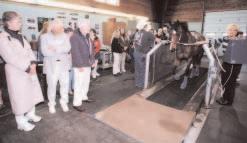

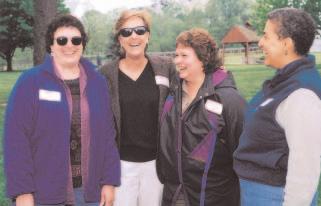


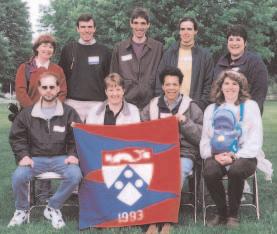
BELL WETHER 57 21
Class of 1978:Karen M.Young,Cynthia D.Bossart,Nancy M.Bromberg,and Mattie J.Hendrick. (JR)
Class of 1958:Richard H.Stoneback,Sr.,Russell J.Snyder,George Bjotvedt, Frederick R.Rude,Gerald E.Lewis,and Richard L.Cook. (JR)
Class of 1943:Harold M.S.Smith,Joseph H.Groveman,and Joseph O. Simington. (JR)
V.M.D.NotesV.M.D.NotesV.M.D.NotesV.M.D.NotesV.M.D.Notes V.M.D.NOTESV.M.D.NOTESV.M.D.NOTESV.M.D.NOTESV.M.D.NOTESV.M.D.NOTES
Class of 1993:Front Row—Randall T.Busch,Ann E.Bastian,Jody M.Hoffman,and Amy L.Hartman with son,Travis.Back Row—Patricia M.Gabig,Mark T.Donaldson, Christopher Dutton,Mary C.McCabe,and Maureen Firth Krout. (JR)
AlumniWeekend 2003
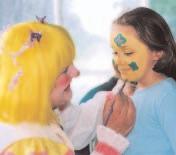
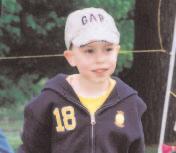
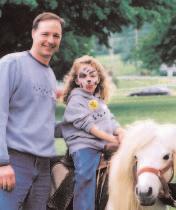
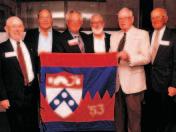

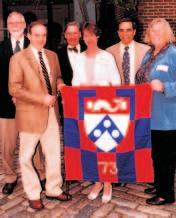

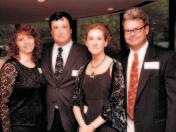
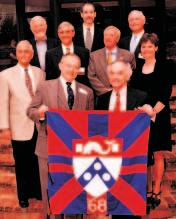
V.M.D.NotesV.M.D.NotesV.M.D.NotesV.M.D.NotesV.M.D.Notes V.M.D.NOTESV.M.D.NOTESV.M.D.NOTESV.M.D.NOTESV.M.D.NOTESV.M.D.NOTES 22 BELL WETHER 57
Class of 1953:E.Jefferies Hathaway,Richard C.Horn, Daniel D.Bleicher,John O.Mason,Hugh J.Coleman, and Albert Singer. (CD)
Class of 1968:Front Row—Joel Rubin,Robert W. Stewart,Sr.,and Alan Bachrach,Jr.Middle Row— Donald B.Shatto,James V.Stewart,George L. Hartenstein IV,and Maron Calderwood Mays.Back Row—Kenneth G.Kagan and Kenton S.Stokes. (CD)
Class of 1988:Karen Lutschaunig,Mark Lutschaunig,Andrea Tasi,and Roger Nicholas. (CD)
Class of 1963: Front Row—Fred Fernich, L.Paul Lanctot,and Katherine A.Houpt.Second Row— Eugene Witiak,Donald W.Merryman,Melvyn G. Wenger, and Gordon W.Robinson.Third Row— Donald R.Shields,William B.Ames,and Sherbyn W. Ostrich.Back Row-Frederic K.Baff,Adolphe D. Greybek, and Norman H. Altman. (CD)
Class of 1973:Vernon R.Durie,Douglas F.Antczak, William H.McCormick,Nancy O.Brown,Randall C. Fertelmes,and Midge Leitch. (CD)
Class of 1998:Martha A.Franklin,Sally Anne Aschenbrand,Margaret W.Gober,and Gerald Thompson. (CD)
2003 Alumni Award of Merit Recipients
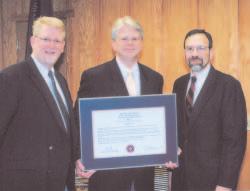
During the Annual Meeting ofthe Veterinary Medical Alumni Society (VMAS) of the University ofPennsylvania School of Veterinary Medicine on May 17,2003,three alumni were honored with a 2003 Alumni Award ofMerit.They are:
Dr.Elinor A.Brandt,a 1963 graduate.A resident ofLos Angeles,she owns East Valley Veterinary Clinic in Sun Valley,Calif.She was honored for her longstanding commitment and dedication as Class Agent for the Class of1963.
Dr.Henry L.Croft,Jr.,a 1978 graduate.A resident ofStahlstown,Pa.,he owns Loyalhanna Veterinary Clinic in Stahlstown,Pa.He was recognized for promoting animal welfare in his community through numerous outreach programs,and for his 23 years ofleadership to the Westmoreland County,Pa.,4-H Veterinary Science Club.
Dr.John D.McCullough,a 1943 graduate.A resident ofAtlantic Beach,Fla.,he was recog-
University ofPennsylvania School ofVeterinary Medicine Veterinary Medical Alumni Society
Salutes
Elinor A.Brandt,V.M.D.
Class of 1963
For your longstanding commitment and dedication to the University ofPennsylvania School ofVeterinary Medicine in your role as Class Agent for the Class of1963.According to a classmate,you have “been the glue that has kept [your] class together and has been instrumental in building bridges for the School.”
For taking an active interest in your profession as a member ofthe American Veterinary Medical Association,the American Animal Hospital Association,the Southern California Veterinary Medical Association,and the Lesbian and Gay Veterinary Medical Association.
The Alumni Award ofMerit is presented to you this 17th day ofMay 2003.
nized for his exemplary service to the U.S.Air Force that spanned 22 years and three continents—during which he rose to the rank ofColonel in the Veterinary Corps,and was honored with an Air Force Meritorious Service Medal for outstanding noncombatant meritorious service during the Korean War.
The VMAS honors alumni who have made outstanding contributions to their profession and the School with the Alumni Award ofMerit.The award is given annually to recognize distinguished graduates for their contributions that advance knowledge in biomedicine,promote the welfare of animals through public education ofanimal
University ofPennsylvania
School ofVeterinary Medicine
Veterinary Medical Alumni Society Salutes
Henry L. Croft,Jr.,V.M.D.
Class of1978
For promoting animal welfare in your community through numerous outreach programs including “Bite-Free,”which educates children on pet responsibility and how to prevent dog bites.
For taking an active interest in your profession as a member ofthe American Veterinary Medical Association,the American Animal Hospital Association,the Pennsylvania Veterinary Medical Association,and the Western Pennsylvania Veterinary Association.
For your service to the community that promotes the good name ofthe School ofVeterinary Medicine, most notably as a member ofthe Advisory Board of the Powdermill Nature Reserve ofthe Carnegie Museum of Natural History,and as a member ofthe St.Vincent College Animal Welfare Committee.
For being honored with the 1991 Public Service Award ofMerit by the Pennsylvania Veterinary Medical Association for outstanding achievements in working with young people to encourage respect and responsibility for nature,animals,and the environment.
For being recognized for 23 years ofleadership to the Westmoreland County,Pa.,4-H Veterinary Science Club.
The Alumni Award ofMerit is presented to you this 17th day ofMay 2003.
owners,and benefit society through civic activities that foster the advancement ofthe profession and the School’s good name.
University ofPennsylvania School of Veterinary Medicine
Veterinary Medical Alumni Society Salutes
John D.McCullough,V.M.D.
Class of1943
For advancing veterinary care in your community by establishing and running a private veterinary practice—specializing in bovine care—in Clarion County,Pa.,from 1943,directly after your graduation, until 1952.
For your exemplary service to the U.S.Air Force that spanned 22 years and three continents—during which you rose to the rank ofColonel in the Veterinary Corps.
For being presented an Air Force Meritorious Service Medal for outstanding noncombatant meritorious service during the Korean War.
For being recognized by the School ofVeterinary Medicine with its Bellwether Medal in 2000 for your exceptional accomplishments that have brought distinguished recognition to the School.
For your generous support ofyour alma mater, including your annual gifts to the McCullough Research Fund at New Bolton Center,which promotes faculty development and leads to improved teaching,research,and service at the School,and your contribution to name the John D.McCullough, V ’43, and Dorothy Wilson McCullough Reception Area in the new Teaching and Research Building.
The Alumni Award ofMerit is presented to you this 17th day ofMay 2003.
BELL WETHER 57 23 V.M.D.NotesV.M.D.NotesV.M.D.NotesV.M.D.NotesV.M.D.Notes V.M.D.NOTESV.M.D.NOTESV.M.D.NOTESV.M.D.NOTESV.M.D.NOTESV.M.D.NOTES
Eric M.Bregman,V’95,VMAS President,Henry L.Croft,Jr.,V’78,and Jeffrey A. Wortman,V’69,Associate Dean.
AVMA Annual Convention Alumni Reception
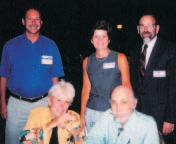
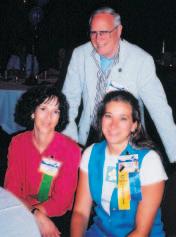
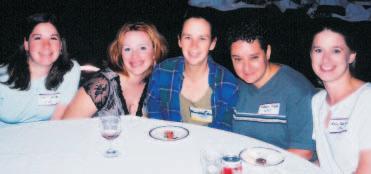

Nearly 75 Penn Veterinary Medicine alumni and their guests attended an alumni reception during the American Veterinary Medical Association Annual Convention in Denver on July 20,2003. Associate Dean Jeffrey A.Wortman, V’69,provided an update on current activities at the School.
Plans are being made for a special alumni reception on the top floor ofthe Loews Philadelphia Hotel,located in the landmark PSFS Building,in honor ofthe 2004 Annual Convention being held in Philadelphia,“The Place that Loves You Back,”July 24–28.
Two Alumni Join AVMA
Raymond Stock,V’75, and Mark Lutschaunig,V’88,have been named new assistant directors in the American Veterinary Medical Association’s Governmental Relations Division office in Washington, D.C.They will be responsible for monitoring the activities ofCongress and federal regulatory agencies while providing liaison activities for the veterinary medicine profession to the federal government and applicable agencies on a variety of issues that could impact the profession.
Israel’s Animals
(continued from page 15)
rarely sees in Israel.) She credits Penn for her ability to make this mental transition.
“Penn Vet really teaches you how to problem-solve in a very organized,efficient manner so you can approach something you’ve never seen before very systematically,”she explains.
When Alexandria,Va.-based CHAI approached her about starting an offshoot in Israel,Levine welcomed the opportunity.“I was excited to be able to make a difference,”says Levine,who brought the U.S.-made mobile clinic to the streets last March.“In a country that’s young,you can really make a difference and pave the way.”
Recently,Levine worked with Israel’s agricultural (veterinary services),environmental, and health ministries to end the strychnine poisoning ofstrays.Also,she was invited to spay/neuter animals in Orthodox communities around Jerusalem,where heretofore these procedures have been prohibited.
While the mobile unit,which is also manned by a driver and a veterinary technician,travels only to familiar neighborhoods, Levine hopes to bring CHAI Israel’s veterinary services to Arab towns that are known to be safe.In August,she took the clinic into the desert to vaccinate and spay/neuter the dogs of the nomadic Bedouins and educate the group about responsible pet ownership.She says that raising Israel’s veterinary standard ofcare is a first critical step in cracking down on needless disease and suffering in animals.
For more information on CHAI,visit <www.chai-online.org>.
24 BELL WETHER 57 V.M.D.NotesV.M.D.NotesV.M.D.NotesV.M.D.NotesV.M.D.Notes V.M.D.NOTESV.M.D.NOTESV.M.D.NOTESV.M.D.NOTESV.M.D.NOTESV.M.D.NOTES
Pantone 432 Pantone 201
Saly Glassman,Opportunity ScholarshipSponsor
by Susan I.Finkelstein
“The Opportunity Scholarship Program is dear to my heart.Veterinary medicine is very important to me,and I’m just delighted to have a real relationship with the University of Pennsylvania Vet School.Penn cares about me as a donor,and I care about the students.”So says Saly Glassman,highly successful financier, accomplished equestrienne,wife,mother of two—and Opportunity Scholarship sponsor.
Several years ago,when asked by Opportunity Scholarship Committee member Andy Elser,V’87,to sponsor a veterinary student in need,Saly immediately seized the chance to get involved.Her love ofhorses— and their prominence in her life—made Ann Kroken,V’04,a natural choice for the recipient ofSaly’s scholarship.
Ann has been a lifelong owner and trainer ofStandardbred horses,has an interest in riding hunter/jumpers,and has been a member ofthe Equine Club since 2000.Raised in Lisbon Falls,Maine,Ann would like to return her home state to pursue a career in equine sports medicine and lameness diagnostics and treatment after graduation.
Growing up in Cheltenham,Pa.,Saly developed an early attachment to animals;at the age of five, she began riding horses,and a lifelong passion was born.She eventually switched from hunters to jumpers and dressage,and has competed extensively as an amateur show jumper.
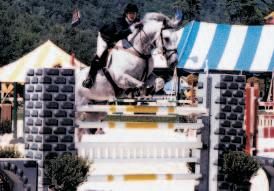
Eight years ago,while looking for a trainer, Saly spotted Irishman Kevin Babington at a show,and his exceptional ability immediately
Opportunity Scholarship Program Committee
Jill Beech,V’72
Andrew H.Elser,V’87
Marie Haddock,V’04
Charles W.Koenig,V’57
Lori Spencer Mann,V’95
Ashra Pearl Markowitz, Assistant Dean for Student Affairs
Leslie McLaughlin,V’06
Brooke Moore,V’05
Dori Myers, Major Gifts Officer
Charles W.Raker,V’42 (Chair)
Lawrence A.Rebbecchi,Jr.,V’90
Brenda Lewis Stewart,V’70
James V.Stewart,V’68
Robert W.Stewart,Sr.,V’68
Marilyn B. Weber,V’75
Jeffrey A.Wortman,V’69, Associate Dean,School ofVeterinary Medicine
was apparent.Kevin soon started training Saly and riding her horses competitively.And so a dynamic,long-term partnership was formed: Kevin has ridden Carling King,Saly’s chestnut Irish sport horse,to several international titles.
psychology—but discovered upon graduation, in the thick ofthe early 1980s recession,that her Ivy League education did not gain her automatic admittance into the tight job market.“My father said,‘You belong in a brokerage house,’and it turned out to be the perfect career for me.”
Twenty-three years later,Saly is Senior Vice President at Merrill Lynch,responsible for the investment strategies ofhigh-net-worth clients (in the $5-million to $50-million market),and heads a team ofsix women whose collective experience exceeds 110 years.
Carling King was eighth in the World Equestrian Games in Jerez,Spain 2002,won multiple international Nation’s Cups in 2003,and was the 2001 Samsung Nation’s Cup leading horse. Of her relationship with Kevin,Saly notes,“We have extremely high standards for ourselves and other people.We’re opposites ofeach other, but together we make each other whole.”
As a student at Cornell in the late 1970s, Saly studied psychology—including animal
Saly’s practice is ranked among the top five in the firm and first in the Delaware Valley district.She has been listed multiple times as one ofthe top 20 financial advisers in the United States.
Saly now makes her home on her 128-acre “Kindle Hill Farm”in Gwynedd Valley,Pa., with her husband of22 years,Allan Syphers,a self-employed architect,and their two daughters,Janice,13,and Lauren,7.
2004 Alumni Award of Merit Nominations Sought
Nominations are being sought for three recipients ofthe 2004 Alumni Award ofMerit, which will be presented at the Veterinary Medical Alumni Society (VMAS) Annual Meeting during Alumni Weekend 2004.
The VMAS honors alumni who have made outstanding contributions to their profession and the School with the Alumni Award ofMerit. The award is given annually to recognize distinguished graduates for their contributions that advance knowledge in biomedicine,promote the welfare ofanimals through public education of animal owners,and benefit society through civic activities that foster the advancement ofthe profession and the School’s good name.
Eligible 2004 recipients are members ofthe classes that end in “4”or “9,”and who will be celebrating a five year reunion during Alumni Weekend 2004.Members ofthe VMAS
Executive Board will select the recipients from the pool ofnominees.Nominations are due no later than December 31,2003.
For more information or ifyou have any questions,please contact Joshua E.Liss,Director ofAlumni Relations and Annual Giving,at (215) 898-1481 or via e-mail at <lissj@vet. upenn.edu>.For a list ofprevious Alumni Award ofMerit recipients,please visit <http://alumni.vet.upenn.edu/ alumniawardofmerit.html>.
To make a nomination,please send a letter explaining your reasons to:
Joshua E.Liss
Director ofAlumni Relations & Annual Giving University ofPennsylvania
School ofVeterinary Medicine
3800 Spruce Street Philadelphia,PA 19104-6047
BELL WETHER 57 25
OPPORTUNITY SCHOLARSHIP PROGRAM
Scholarships
The American Kennel Club awarded a Chairman’s Scholarship to Dana Clark,V’06. Garret Patchinger,V’05,received a Western States Scholarship. SCAVMA Community Service Grants were awarded to Daphne Downs and Robert Mankowski,Class of’04; David Shere and Zoe Ramagnano,Class of’05; and Jennifer Feiner and Jennifer Swallow,Class of’06.Three members ofthe Class of’06 each received a Donald E.Cross Scholarship for Large Animal Medicine:Lauren Green,Caitlin Roberts,and Alison Wolfgram.
James Shissler,V’04,and Ellen Angstadt, V’04, each received a Wagner Rural Medicine Scholarship.Anne Prickett,V’04,received the Lloyd’s Equine Research and Education
Program Scholarship.The Dauphin County Resident Scholarships were awarded to Lauren May,V’05,and Mary Palopoli,V’06.
Lois F.Fairchild Scholarships in Veterinary Public Service were awarded to Aylin Attila, V’04, Alison Loupos,V’05,and Emily Jones, V’05.Four members ofthe Class of’04 received Pennsylvania Veterinary Foundation Scholarships:Jill Compton,Josh Eaton,Cailin Heinze,and Laura Javsicas.The Westminster Kennel Foundation Scholarship was awarded to Christa Regan,V’04.Five members ofthe Class of’04 each received a Dr.J.E.Salsbury Scholarship: Josh Eaton,Lauren Entes,Carrie Horton,Jennifer Kaae and Christa Regan. University ofPennsylvania Hertzler
New DNA Test for MPS VI in Miniature Pinscher
A new DNA-based test for mucopolysaccharidosis type VI (MPS VI) to identify affected,carrier,and normal miniature pinschers has been developed by researchers at the School.
MPS VI,an inherited lysosomal storage disease, has been seen in cats.The miniature pinscher is the first dog breed in which it has been identified.Affected miniature pinschers have been found in various states in the US and abroad,making this appear to be more widespread and under-diagnosed than previously thought.Diseases in the MPS group inhibit the cells’ability to break down large sugar molecules and parts ofthe molecules accumulate in cells.This leads to deformities oflimbs, vertebrae,sternum,and particularly,the hips. Affected animals may also have corneal cloudiness and facial malformations.
The test identifies affected,carrier,and normal miniature pinschers.Identification of carriers is particularly important as they show no signs ofthe disease.By knowing who the carriers are,breeders can avoid mating two carriers,which could produce affected animals, and will assist in eliminating the mutant allele altogether from the breed.
The test was developed by Dr. Polly Foureman,a Josephine Deubler Fellow in the School’s Section ofMedical Genetics.The DNA-based test requires a blood sample to be submitted to the Josephine Deubler Genetic Disease Testing Laboratory at Penn.The research and test development were supported
by grants from the AKC Canine Health Foundation and the National Institutes ofHealth.
The Penn medical genetics researchers, under the direction of Dr.Urs Giger,are also examining whether the common occurrence of Legge-Calves-Perthes (LCP) disease in miniature pinschers and other breeds is related to MPS VI.LCP,a devastating hip disease,is characterized by necrosis ofthe femur head. The cause remains unknown.LCP differs from hip dysplasia and MPS VI,but similar bone changes are observed in miniature pinschers with MPS VI.Penn’s researchers want to determine ifthere is an association between MPS and LCP disease in this and other breeds with LCP disease.This study is done by Lisa Berman,senior biology student at Penn,and is also funded by the AKC Canine Health Foundation.
Dr.Giger and his colleagues are requesting that breeders,owners,and veterinarians who suspect either condition in a miniature pinscher contact the laboratory.For a limited time the first 100 samples will accepted free of charge.Test results will be kept confidential and information about individual animals will only be reported to the owner.For further information,please visit the web site at <www.vet.upenn.edu/penngen> or contact Dr. Giger or Dr.Lisa Sarvas,the current Deubler Fellow,at <penngen@mail.vet.upenn.edu> or by fax at 215-573-2162.
Scholarships were awarded to Timothy Mosebey,V’05,and Michelle Regester,V’06.The Union County Kennel Club awarded a scholarship to Rebecca Taylor,V’05.Josh Eaton,V’04, and Kelli Russell,V’04,each received a Ch. Forfox Liz Claiborn Scholarship.The Swiss Benevolent Society awarded a scholarship to Nadine Salome,V’06.
Shirley E.Possinger Dean’s Scholarships were awarded to the following members ofthe Class of’04:Beth Appleman,Mandy Becker, Cailin Heinze,Lisa Lipitz,Adriane Pfeninger, and Tara Strawderman;and to the following members ofthe Class of’06:Gordon Peddle, Kimberly Russell,Jennifer Stevens,Kristina Willoughby,and Daniel Zawisza.
Ann Kroken,V’04,received a Charles F. Reid Dean’s Scholarship.The Eric Tulleners Dean’s Scholarship was awarded to Angela Davies,V’04.The following members ofthe Class of’04 received Anne Linn White Dean’s Scholarships:Allison Billings,Kristen Hart, Laura Javsicas,Megan Manfredi,and Todd Strochlic. Charles S.and Phyllis H.WolfDean’s Scholarships were awarded to the following members ofthe Class of’04:Dora Connelly, Rachel Pearson,and Abigail Smith.
Mrs.Jack L.Billhardt Dean’s Scholarships were awarded to the following members ofthe Class of’04:Michele Koch,Bjorn Lee,Kelli Russell, and Arlene Schneiderman.
The following members ofthe Class of’04 are the recipients of Dr.M.Josephine Deubler Dean’s Scholarships:Kara Ballek,Holly Edwards,Oli Morgan,Regina Pellegrin,and Erin Wright.
Rebecca Schrader V’04,and Jennifer Seybold, V’04,are each a recipient ofan Ethel H.Mitchell Dean’s Scholarship. Bruce J.Heim Dean’s Scholarships were awarded to the following members ofthe Class of’04:Aylin Attila,Stephen Godin, and Courtney Maeda.Garret Patchinger,V’05,is the recipient ofthe Jack Mara Dean’s Scholarship. Hill’s Pet Product Dean’s Scholarships were awarded to the following members ofthe Class of’05:Jessica Bertout,Christopher Blum, Amanda Bowden,Meghan Brumstedt,Jennifer Cohen,Anthony Dallatore,Amy Durham, Laurel Frydenborg,Kaira Geithman,Sabrina Goscilo,Justin Kontir,Audra Olsen,and Aimee Simpson;and to the following members ofthe Class of’06:Anthony Acquaviva,Rachel Choi, and Christine Claycomb.
The following members ofthe Class of’04
(continued on page 30)
26 BELL WETHER 57
Animal Crackers
Nova Scotia DuckTolling Retriever
The Nova Scotia duck tolling retriever is the latest breed eligible to compete for championship points at shows held under American Kennel Club rules.There are now 150 breeds and varieties eligible for the regular classes at these shows.
Tolling is a Middle English word meaning “to lure or decoy game.”The running back and forth along the shoreline arouses the curiosity ofthe waterfowl and causes them to swim closer to the shore within gunshot range.The dog is sent to retrieve the dead or wounded birds.
It is thought that the basic stock was the red decoy dog brought to Nova Scotia by early settlers from Europe;crosses with other breeds, possibly setter or spaniel-type dogs and farm collies,produced the present-day toller,which has bred true for generations.It was granted official breed status by the Canadian Kennel Club in 1945.At first,it was seldom seen outside Nova Scotia but today it may be found across the United States and Canada as well as in Europe and Australia.The parent club in the United States was formed in 1984 to promote interest and safeguard the future ofthe breed.
The toller is the smallest ofthe retrievers— a medium dog in every way:medium size, medium coat, medium bone.The ideal height for a male is 19 inches,for a female 18 inches. It has a water-repellent coat and soft,dense undercoat—the tail is luxuriant and well feathered.Coat color is any shade ofred.
This dog is incorrectly described as a small golden retriever although it may seem so to the untrained eye.The breed standard gives a complete description.This can be found on the AKC website—<www.akc.org>.
Indoor and Outdoor Cats
An estimated 73 million cats live in 32 percent ofthe households in the United States.In addition,there are large numbers offreeroaming cats—owned cats allowed to go outside as well as stray and feral cats.Every year, 70 percent (3 to 4 million) ofcats that enter the nation’s shelters are euthanized. There are many strictly indoor cats while others are allowed outdoors for a few hours during the day.Some cats are allowed unlimited outdoor access.In our society,many believe that cats are independent and can largely take care ofthemselves.Some educational
programs promote indoor lifestyles for cats because ofthe feral cat issue and to prevent illness or death associated with outdoor access. In addition,owned cats generally live longer, healthier lives than strays.

Overpopulation is a problem.Although no easy answers exist,responsible owners who have their cats neutered can help.Not only does neutering prevent unwanted kittens (one female cat and her offspring can produce as many as 420,000 kittens in seven years),but it can curb or eliminate problematic behaviors, reduces the risk ofseveral types ofcancer,and makes pets better,more affectionate companions overall.
Owner or Guardian?
Recently there have been proposals that the term “guardian”should be used instead of “owner” of dogs.

AKC has issued a position statement on this,supporting the use ofthe term “owner” when referring to the keeping ofdogs.AKC believes that the term guardian reduces the legal status and value ofdogs and thereby restricts the rights ofowners,veterinarians and government agencies to protect and care for dogs.It may also subject them to frivolous and expensive legislation.
The term guardian does nothing to promote more responsible treatment ofdogs.AKC strongly supports efforts to educate the public about responsible dog ownership to ensure that all dogs receive the care,love,and attention they deserve.

Bits and Pieces
• Print or type an “Emergency Care of Companion Animals”card and place it in your wallet.List all your animals and who should be contacted in case you are injured or hospitalized and cannot return home.
• Acetaminophen is very toxic to cats—as little as 50 milligrams can poison the averagesized cat.The drug is the active ingredient of Tylenol™ and other over-the-counter medication.Cats handle medications differently than humans and dogs and a veterinarian should be consulted before medication is given to cats.
• Large amounts ofchocolate may be dangerous to dogs.The toxic ingredient is theobromine,which is similar to caffeine.Signs of overdose include hyperactivity,fast heart rate,
and possibly seizures.Small amounts may not cause any trouble although very large doses could be fatal.About 50 milligrams oftheobromine per pound ofbody weight can cause trouble.Milk chocolate has about 44 milligrams per ounce,semisweet chocolate has 150 milligrams per ounce,and baking chocolate contains 390 milligrams per ounce.Do the math and decide ifveterinary help is needed.
The ASPCAAnimalPoison ControlCenter helpline is 888-426-4435.There is a consultation charge of$45;have your credit card at hand when you call.
• Declawing ofdomestic cats is a controversial procedure recently banned in West Hollywood,Calif.It is illegal in 25 countries but has advocates and opponents in the United States. The American Veterinary Medical Association (AVMA) has a position statement stating the declawing should be considered only after attempts have been made to prevent the cat from using its claws destructively or when its clawing presents a zoonotic risk to its owners. The AVMA believes the veterinarian should provide cat owners with complete education regarding feline onychectomy.Scratching is a normal feline activity.Owners must provide scratching posts or other implements tall or long enough to allow full stretching and firmly anchored to resist scratching.Claws should be trimmed every 1 to 2 weeks.Declawed cats should be housed indoors.Surgery may be considered ifscratching behavior would lead to the removal ofthe cat from the household.
More Groups of Animals and Others
a business offerrets

a tower ofgiraffes
a bloat ofhippopotamuses
a romp ofotters
a crash ofrhinoceroses
a scurry of squirrels
a streak oftigers
a convocation ofeagles
a stand of flamingoes
a gaggle ofgeese
a parliament ofowls
a murmuration ofstarlings
a mustering ofstorks
a hover oftrout
an intrusion of cockroaches
a smack ofjellyfish
BELL WETHER 57 27
SpecialGifts to the School
THE FOLLOWING GIFTS WERE MADE TO THE MATTHEW J.RYAN VETERINARY HOSPITAL OF THE UNIVERSITY OF PENNSYLVANIA
In memory of a special pet:
Ms.Robin Bausback in memory of“MOLSON GOLDEN”
Mr.and Mrs.Michael Beattie in memory of“ABBY”
Mr.and Mrs.Mark Bofinger in memory of“JOSHUA”
Ms.Julia M.Bruno in memory of“TASHA”
Mr.and Mrs.Alfred Cavallaro in memory of“TROOPER”& “POLLY”
Mr.and Mrs.Albert J.Ciccone in memory of“RORY”
Ms.Christine L.Cook in memory of“OSIRUS”
Ms.Cindy H.Davis in memory of“CAESAR”
Ms.Marilyn Dietrich in memory of“COCOA,”“SPANKY,”“SUSIE,”& “SPOT”
Mrs.Gertrude M.Dukeman in memory of“CATT”
Mr.Joe Dugan in memory of“MOLSON”
Mr.and Mrs.Christopher J.Fahey in memory of“PEPPER”& “CINNAMON”
Ms.Sonia R.Flegeal-Kipp in memory of“NIKITA”
Mr.and Mrs.Michael S.Ford in memory of“CHANCE”
Mrs.Loretta Goldberg in memory ofher deceased animals
Mr.and Mrs.Scott Green in memory of“BELLE”& “SPORT”
Ms.Vickie Grier in memory of“FUDGIE”
Ms.Kelly A.Inemer in memory of“VELVET”& “BABY TIGGER”
Mrs.Aubrey J.Johnson in memory of“SARAH”
Ms.Jean A.Kift in memory of“CHELSEA”
Ceil and George Kostick in memory of“LIBBY”& “MISTY”
Mr.Sam Harris and Mrs.Linda Kronfeld in memory of“TAILOR”
Mr. and Mrs.Kenneth C.Malek in memory of“PITCH BLACK,” “ROXANNE,”“CYRANO,”“MUFFIN,”“CAINE,”“LASSIE,” “BUBBIE,”“MINNIE,”& “APRIL”
Mr Michael A.Marino in memory of“SNICKERS”
Mr.and Mrs.Clarence E.McCann in memory of“NOEL”
Mr.William R.McKeever in memory of“PAL,”“SCOTTIE,”“PIPER”
Mr and Mrs.David Mealmaker in memory of“NELSON,”“COCO,” “CODY,”& “BO”
Mr.and Mrs.David W.Monahan in memory of“TARA”
Mrs. MaryJeanette Monihan in memory of“BUBBA”
Ms.Autumn Ning in memory of“UNI”
Mr.and Mrs.Donald F.Pascucci in memory of“REMO”
Mrs.Maggie Pennock in memory of“MAGIC”
Ms.Susan S.Rachford in memory of“NIKE”
Mrs.Joanne Reinert in memory of“BUDDY”
Ms. Nancy Roberts in memory of“BUFFY”& “JAIME”
Mr.and Mrs.Gregg A.Runyen in memory of“JESSIE”& “MEGGIE”
The Scioscia Family in memory of“MUFFY”
Mr.Samuel R.Scott in memory of“ROMEO”
Ms.Sheryl M.Simmons and Mr.Bruce Darkes in memory “JUBAL”
Ms. Tawn J.Stokes in memory of“LINUS”
Dr.Karen Seamans in memory of“TRAVIS ALLEN”
Mr.and Mrs.L.Ray Stillman in memory of“GRETCHEN”
Ms. Vicki A.Ungar in memory of“BENNY”
Mr. Phillip E.Walker in memory of“BUTLER”
Mr.Gary Walsh in memory of“QUINCE”
Mr and Mrs. G. D Wargo in memory of“NISSA”
Mrs. Pearl I.Weisberg in memory of“MYLO”
Mr.and Mrs.Terrance V.Ware II in memory of“CARLA”
Gift for New Bolton Center
Thoroughbred Charities ofAmerica,Ltd. (TCA) made a $40,000 gift to New Bolton Center.The funds will be used to augment and refine the diagnostic equipment in the Scott Equine Sports Medicine Building, which opened last year.TCA was a major contributor to the building fund.
New Bolton Center is just one ofthe many institutions and organizations benefiting from TCA’s mission to support equine research,education,and the welfare ofthe
In memory of those listed:
Mrs.Paula Ann Granger in memory ofJohn Granger and DawnElaineGranger
Mr.and Mrs.Ernest K.Keene in memory ofVirginia Santandrea
Mr.and Mrs.John L Mengal in memory ofDave G.Thompson
Mr.George E.Myatich in memory ofIrene and Linda Rak
Ms.Katherine M.Rhoads in memory ofVirginia Santandrea
In memory of The Honorable Matthew J.Ryan:
Mr.and Mrs.Edward J.Barder
Mr.Daniel E.Beren
Elizabeth A.Bresnan
Mr.and Mrs.A.Scott Briner
Ms.Joan M.Brod
Cabot Properties L.P.
Carroll & Karagelian,LLP
Martin T.Causer
Kathleen F.Coulston
County Commissioners Association ofPennsylvania
Ms.Lynne Cutler
Constance M.Darmiento
Mr.and Mrs.Michael DeFino
Delaware County Authority
Delaware County Bar Association
Mr.and Mrs.Bernard J.Devlin
Mr.and Mrs.John R.Donaphon
Mr.and Mrs.Eric A.Dowson
Family & Community Service Delaware County
Maureen F.Fitzpatrick
IfIt’s Water,Inc.
Friends ofSenator Jubelirer
Yolanda J.Galantino
Gordon W.Gerber,Esq.
Alfred A.Gilbert
Michael F.X.Gillin & Assoc.,P.C.
Mr.and Mrs.Joseph F.Granger,Jr.
Kenneth W.Green,Jr.,CPA
Nancy C.Harvin
Ms.Vicki Herr
Dr.Paula K.Hess
O.Warren Higgins
Highmark Inc.
Mr.Henry L Hillman
Robert T.Hofmann and Assoc.Inc.
Holston & Associates Attorneys-at-Law
Mr.and Mrs.John B.Huffaker
Hughey L.Law PC
Mr.and Mrs.David W.Hunter
Ms.Louise M.Hutchinson
Independence Blue Cross
Peter E.Irish
Mr.and Mrs.Robert A.Judge
Mr.Thomas J.Judge Sr.
Judges Miscellaneous Fund
William F.Keller
Mr.and Mrs.Charles Gerard Kramer
Kramer-Warner Associates,Inc.
Thoroughbred horse.A stallion season and sporting art auction are held each December at CandyLand Farm,the home ofHerbert, W’53,and Ellen Moelis in Middletown, Del.,to raise funds.The 2003 event is slated for December 6 and anyone who wishes to donate a stallion season or any silent auction item to benefit New Bolton Center can designate NBC as the beneficiary ofthe proceeds.For information,please visit the TCA website <www.thoroughbredcharities.org>.
Gary R.Kraus
Lancaster Delegation (Thomas Creighton)
James S.Lawlor
Dorothy H.Lawrence
Arthur Levy
Lima Fire Company No.1 Fire Division
Mr.Nicholas J.Maiale
Mr.and Mrs.Howard R.Majev
Mrs.Mary Alice D.Malone
Mrs.Dorothy A.Matz
Mr.and Mrs.John J.McFadden
Michael C.McLaughlin LLC
Mr.and Mrs.C.M.Meyer,Jr.
Patricia A.Murphy,Esq.
Northeast Republican Caucus
Northwestern Mutual Life Insurance Co.
Ms.Margaret R.O’Rourke
PA Breast Cancer Coalition
Mr.George A.Pagano
Mr.H.Sheldon Parker,Jr.
Dilworth Paxson LLP
PECO Energy
Pennsylvania Manufacturers Association
Pennsylvania’s Unified Judicial System
Pepper Hamilton LLP
Mary E.Ray
Mr.and Mrs.Eugene F.Reilly
Republican Federal Committee ofPA
William S.Roohan
Mr.and Mrs.Chad E.Saylor
The Hon.Frank A.Salvatore
Mr.Larry O.Sather
Schumacker and Lunkenheimer,LLP
Mrs.Sarah Spang
Senate Republican Caucus
Mr.and Mrs.John E.Sherry
Ms.Gertrudeann L.Smith
Ms. Nancy C. Subashi
The Swarthmore Group
Ms. Katherine True
Upper Providence Township General Fund
Ms. Marilyn Ware
Helen M.White
Helen T White
Eric R. Wolfe
Wachovia Corporation
Women’s Association for Women’s Alternatives,Inc.
In memory of Frank Kenton Cashell:
Mr.Tim Arnold
Mr.and Mrs.Richard J.Collins
Mr.Wayne Carson
Ms.Loretta Dougherty
P.S.DuPont Class of1948
Ms.Sarah Erhart
Ms.Mary Ann Fagan
Ms.Carol Gawthrop
Ms.Sandy Grady
Mr.and Mrs.William Thomas Green III
Ms.Trudi Hood
Ms.Sharon Hubbs
Ms.Beth Jackson
Ms.Flo Jaros
Mr.and Mrs.John P.Jessup
Ms.Renie E.Kelly
Mr.and Mrs.Robert C.Linderman
Ms.Stacie Lynch
Ms.Carla McDougal
Mr.and Mrs.Michael McGrath
Mr.Dave McIlvaine
Mr.and Mrs.C.Raeford Minix
Ms.Shelly Morrison
Mr.Joe Murphy
Ms.Nancy Oberlin
Peck,Shaffer & Williams LLP
Ms. Norma Petersen
Ms.Cheryl Pittenger
Property Advisors Corporation
Mrs.Joanne Raffel
Mr.Bud Rice
Mr.and Mrs.William R.Sands
28 BELL WETHER 57
Mr.and Mrs.John M.Sergeant
Mr.Steve Szczerba
Ms.Joni Ward
Mr.Sam Wardell
Mr.George Williams
Mr.Don Wilson
Ms.Joyce Woods
In memory of Linda Kaintz:
Ms.Lynn Amey
Ms.Sandy Barton
Mr.and Mrs.Michael J.Basile
Ms.Linda Coco
Ms.Stephanie Davis
Mr.and Mrs.David J.Dulick
Ms.Laurie M.Ernest
Mr.Thomas Herd
Ms.Arleen Laporte
Mr.and Mrs.E.James Monihan
Mr.and Mrs.Phillip G.Pinton
Mr.John Shearer and Mrs.Patricia A.Fox
Ms.Eleanor G.Streletzky
Mr.and Mrs.Richard J.Strusowski
Ms.Lynn Wilkins
Mr.and Mrs.Larry Zipprich
In honor of a special pet:
Mrs.Dory Dore in honor of“BOO-BOO”
Ms.Diane Frances in honor of“MAX”
Ms.Jodi Heffer in honor of“MAGIC”
Ms.Rebekah S.Klein in honor of“EBON”& “GRIFFIN”
Mr.and Mrs.Joel E.Marcus in honor of“BREEZY”
Mr.Robert S.Marcus in honor of“MURPHY”
Ms. Janice F Palmer in honor of“BURKLEY”
In honor of those listed:
Mr.and Mrs.Lance Beatty in honor ofDr.Cullen
Mr and Mrs. Joseph J.Bohovic in honor ofDr.Lillian Duda
Ms.Diane Frances in honor ofDr.Lillian Duda
Mrs.Joanne Frazier in honor ofDr.Elizabeth LaFond
Mr Sam Harris and Mrs.Linda R.Kronfeld in honor ofKayla Rayne Kapito’s Bat Mitzvah
Mr.Robert S.Marcus in honor ofDr.Robert Washabau and Dr.Lillian Aronson
Lila and Janie Matlin in honor ofKathy and Ron Medford’s birthdays and their anniversary
Ms. Letitia O.Principato in honor ofBernice M.Carlin
Mr and Mrs. Arthur A.Reale in honor ofMs.Nona J.Starzyk’s birthday
Bonnie Timmons and Bill Wunsch in honor ofShane ofWest Marlborough
The following made gifts supporting the Clinical Studies Research Development Fund in memory of a special pet:
Mr.and Mrs.Garloffin memory of“BOO”
Mr.Jon R.Simpson in memory of“KEANA”
Ms. Nancy Sullivan in memory of“CHERRY POP (aka TOOMEY),” “PUFF,”“MAGGIE”
The following made gifts supporting Clinical Research in memory of those listed:
Mr.David K.Erikson in memory ofLorraine N.Erickson
The following made gifts supporting Clinical Research in honor of those listed:
KKI, Inc. in honor ofDr.Margret Casal
The following made gifts supporting the Radiation Therapy Facility Fund in honor of a special pet:
Ms.Gloria J.Bain in honor of“BRITTANY”
Ms. Karen Bain in honor of“BRITTANY”
The following made gifts supporting Oncology Research in memory of a special pet:
Mr.and Mrs.Mark D.Blasko in memory of“BAILEY BOO BOO KITTY”
Ms. Venecia M.Dotter in memory of“TRACKER”
Ms.Joan Plowman in memory of“SAMPSON”
The following made gifts supporting Oncology Research in honor of those listed:
Ms. Carolyn R.Rowan in honor ofDr.Elizabeth McMurtrie
The following made gifts supporting Oncology Research in honor of a special pet:
Ms.Carolyn R.Rowan in honor of“LULU”
StretchYour Racehorses... Resources

A life income gift can help you stretch your charitable giving resources. Charitable remainder trusts and charitable gift annuities are tax-deductible contributions that allow you to keep income from the assets that you donate. Proceeds go to the School of Veterinar y Medicine, Ryan Veterinary Hospital,or New Bolton Center after your death.
• With rates at 5% to 9.5%,you might even double or triple your return.
• You will enjoy significant tax savings.
• Some plans pay tax-exempt income.
• It’s like the Trifecta of charitable giving.
To learn more,please consult our gift-planning expert: Janine Ehsani,Office of Gift Planning, 215-898-6171 or 1-800-223-8236,ehsani@ben.dev.upenn.edu.
The following made gifts to the Orthopedics Research Fund in memory of a special pet:
Ms. Christine M.Gilbert in memory of“TEDDY”
The following made gifts supporting Dr.Maggie Casal’s Canine Genetic Disease Research in memory of a special pet:
Mrs. Helma N.Weeks in memory of“SASSY”
The following made gifts supporting Dr.Beth Callan’s Genetic Disease Research in honor of those listed:
Ms. Linda G. Burka in honor ofDr.Beth Callan
The following made gifts supporting Dr.Meryl Littman’s Soft Coated Wheaten Terrier Research in honor of those listed:
Mr and Mrs.Dean S.Geibel in honor ofDr.Meryl Littman
THE FOLLOWING CONTRIBUTED TO THE DEAN’S FUND:
In memory of those listed:
Robert Adey,V.M.D.in memory ofRichard Blickman,V.M.D.
Dr.and Mrs.Robert W.Despres in memory ofDonald G.Veburst, V.M.D and Stanley Owen Travis,V.M.D.
Linda Schaffer,V.M.D.in memory ofDr.Harvey Waltz
BELL WETHER 57 29
$10,000charitablegiftannuity (fixedincome) $100,000charitableremainderunitrust (variableincome) Ageofincome beneficiary Incomerate One-timeincome taxdeduction Incomerate One-timeincome taxdeduction 60 5.7% $2,269 5.0% $39,792 65 6.0% $2,869 5.5% $43,380 70 6.5% $3,401 6.0% $47,911 75 7 1% $4,006 6 5% $53,173 80 8.0% $4,585 7.0% $59,258 85+ 9.5%(max.rate) $5,017+ 7.5%+ $65,662+ Sample Benefits (one income beneficiary)
Dean Rush Shippen Huidekoper on Pandora in an Eadweard Muybridge study in the late 19th century.(We stretched the picture.)
In memory of a special pet:
Ms.Irene T.Decker in memory of“DILLON”
Ms.Denise L.Goodnow in memory of“TIGGER”
Mr.Joseph R.Jablonski in memory of“MAX”
In honor of those listed:
Ms.Christine Gilbert and “BUDDY”in honor ofDr.Meg Sleeper
Mr.and Mrs.Robert B.Hammel in honor ofTaryn Draxler’s graduation from Medical School at Temple
Donald A.Marcus,V.M.D.in honor ofMr.and Mrs.Herbert Marcus
Bruce Schmucker,V.M.D.in honor ofG.Allen Haus,V.M.D.
In honor of a special pet:
Mr.Joseph Divito in honor of“JACK”
THE FOLLOWING CONTRIBUTED TO THE HUMANITARIAN FUND:
In memory of a special pet:
Ms.Bonnie Hillman in memory of“MACDUFF”
In honor of a special pet:
Ms.Bonnie Hillman in honor of“GEORGE”
Michael Poulshock and Sunanda Ghoush in honor of“ANJOU”
In honor of those listed:
Michael Poulshock and Sunanda Ghoush in honor ofthe Doctors and nurses who saved “ANJOU”
Bellwether
University ofPennsylvania School ofVeterinary Medicine
Editor
Helma Weeks
Photographers
Candace diCarlo
Addison Geary
Jim Roese
Writers
Stephen Bradt
Josephine Deubler,V.M.D.
Susan I.Finkelstein
Joan Capuzzi Giresi,V.M.D.
Helma Weeks
Alumni Relations Liaison
Joshua E.Liss
We’d like to hear your praise,criticisms,or comments. Please address your correspondence to:
Helma Weeks
University ofPennsylvania
School ofVeterinary Medicine
3800 Spruce Street
Philadelphia,PA 19104-6010
(215) 898-1475
hweeks@vet.upenn.edu
None ofthese articles is to be reproduced in any form without the permission ofthe editor of Bellwether
©Copyright 2003 by the Trustees ofthe University ofPennsylvania.
The University ofPennsylvania values diversity and seeks talented students,faculty and stafffrom diverse backgrounds.The University ofPennsylvania does not discriminate on the basis ofrace,sex,sexual orientation,religion, color,national or ethnic origin,age,disability,or status as a Vietnam Era Veteran or disabled veteran in the administration ofeducational policies,programs or activities;admissions policies;scholarship and loan awards;athletic,or other University administered programs or employment. Questions or complaints regarding this policy should be directed to:Executive Director,Office ofAffirmative Action and Equal Opportunity Programs,3600 Chestnut Street, Sansom Place East,Suite 228,Philadelphia,PA 19104-6106 or (215) 898-6993 (Voice) or (215) 898-7803 (TDD).
THE FOLLOWING CONTRIBUTED TO THE VETERINARY STUDENT SCHOLARSHIP FUND:
In memory of those listed:
David H.Allgeier,V.M.D.in memory ofDr.Eric Tulleners
Emily Graves,V.M.D.in memory ofDr.Eric Tulleners
Kristen S.Haviland,V.M.D.in memory ofMrs.Carol McDevitt
Jonathan E.Meincke,V.M.D.in memory ofDr.and Mrs.Lester R. Barto
Michele L.Paul,V.M.D.in memory ofElizabeth Claffey,V.M.D.
Thomas S.Sanquini in memory ofDr.Robert Brody
In honor of a special pet:
Ms.Barbara R.Strauss in honor of“TUPTIM”
In memory of a special pet:
Regina DeLorenzo,V.M.D.in memory of“BANDIT”
THE FOLLOWING CONTRIBUTED TO THE DR.DAVID H.KNIGHT MEMORIAL FUND:
Ms.Anita D.Bodell
Mr.Eric D.Knight
Susan Lazarus Trust
THE FOLLOWING CONTRIBUTED TO THE NEW TEACHING AND RESEARCH BUILDING FUND:
In memory of a special pet:
Charles N.Bell,V.M.D.in memory of“LOOCH”
THE FOLLOWING MEMORIAL OR HONORARY GIFTS WERE MADE TO NEW BOLTON CENTER:
In honor of a special person:
Dr.Richard O.Davies in honor ofDr.James Orsini
Charles J.Driben,V.M.D.and Burl-Moor-Driben Animal Hospital in gratitude for services by Saul Bresalier
Patricia Heukeroth,Inc.in appreciation ofDr.Jill Beech
Mr.& Mrs.Paul Schultz in appreciation ofDr.Eric Parente
Max L.Sponseller,V.M.D.in honor ofCharles W.Raker,V.M.D.
Amy J.Worrell,V.M.D.with thanks to Dr.Karsten Velde
In memory of a special person:
Mr.Eric T.Haas in memory ofDr.Eric P.Tulleners
Mrs. Doris Boucher Ritter in memory ofWilliam B.Boucher,V.M.D.
In honor of a special animal:
Ms. Eileen M. Corl in honor of“CLOVER”
In memory of a special animal:
Ms. Charlotte F.Boehls in memory of“HAPPY”
Jennifer K. Buchholz,V.M.D.in memory of“ASTRO”
Mr.& Mrs.Barry E.Cosel-Pieper in memory of“GAMBIT”
Ms. Aileen J.Elliott in memory of“SPENCER”and “RED FRED”
Mr.& Mrs.John J.Gabel in memory of“PEPE”
Scholarships
(continued from page 26)
were awarded Henry S.McNeil,Jr.Dean’s Scholarships:William Culp,Daniel Eisenberg, Timothy Georoff,Jill Kalman,and Steven Zedler. J.Maxwell Moran,Sr.Dean’s Scholarships were awarded to the following members ofthe Class of’06:Kathryn Colyer, Gillian Harclerode,Kathleen Jenson,Mariah Kachmarik,Leslie Kuczynski,Tara McCafferty, Leslie McLaughlin,and Sarah O’Neill.
Nina Atwood,V’05,Janee Carr,V’05,Marie Haddock,V’04,and Christina Valliant,V’04, each received an Ethel G.and Allen H.Carruth Dean’s Scholarship.
Samuel T.and Emily Rawnsley Dean’s Scholarships were awarded to the following
Hilltop Farm,Inc.in memory of“COLTON”
Hilltop Farm Inc.in memory of“CONTIKI”
Hilltop Farm,Inc.in memory of“LATUNJA”
The Netter Family in memory of“THUNDER”
Ms.Theresa Ann Zappone in memory of“SUNSHINE”
The following gifts were made in memory of Mrs.Dolly Pouska: Abrams Service Station
Acorn Hill Farm
Wayne & Susan Chatfield-Taylor
Jereline & B.C.Dickens
Mr.P.F.N.Fanning
B.R.& D.J.Firestone
Mr.Daniel Hall
Hicks Home for Funerals for Mock,Mary,Jeanette,Sharon and Diane Mary Hillberry & Steven Max
Mrs.Bettina Jenney
Carey K.Miller
Mrs.J.Maxwell Moran
Ms.Henrietta Moyer
David & Christine Nibouar
Northview Stallion Station,Inc.
Mr.Robert Piascinski
Mr.Jerome C.Pouska,Sr.
Ms.Ruth R.Pouska
Ms.Mildred Vrzalik,Ms.Camilla A.Hugunin,& Marie R.Hillberry Worthington Farms
OTHER MEMORIAL OR HONORARY GIFTS TO NEW BOLTON CENTER:
A gift was made toward the Raker-Tulleners Endowed Fund by Malcolm Borthwick,Jr.,V.M.D.in honor ofCharles W.Raker, V.M.D.
A gift was made toward The Spot Castle Fund by Mr.and Mrs.John K. Castle in honor ofDr.James A.Orsini and in memory of“SPOT”
A gift was made by Ms.Margaret Gardner in honor ofJill Beech, V.M.D.
A gift was made toward Neonatal Research by Joanne Hardy,V.M.D., Ph.D.in honor ofDr.Pam Wilkins and Jonathan Palmer,V.M.D.
A gift was made by Sarah L.Ralston,V.M.D.to the Dr.Charles F.Reid Scholarship Fund in his honor
A gift was made toward the William B.Boucher Field Service Award by Mrs.Doris Boucher Ritter in memory ofWilliam B.Boucher, V.M.D.
A gift was made toward Dr.Virginia Reef’s Research by Ms.Suzanne E. Taber in memory of“MURPHY”
A gift was made by James F.Thompson,Jr.,V.M.D.to the Dr.M.Lynn Sammons Award in Bovine Medicine in her memory
members ofthe Class of’05:Rachel Cianciolo, Derek Cissell,Stephanie DiFrischia,Hannah Flynn,Nora Grenager,Lauren May,Brian Palmiero,Zoe Ramagnano,Sarah Reuss,Fred Wininger,and Billie Zeigler.
Alberto Rullan-Mayol,V’06,is the recipient of the Dr. John Baxter Taylor Dean’s Scholarship. New York Farmers Scholarships were awarded to the following members ofthe Class of’04:Ellen Angstadt,Raul Casas-Dolz, Alexander Simon,and James Shissler. Eberhard LeSchin Founders Scholarships were awarded to the following members ofthe Class of’04: Vivian Orita,Jocelyn Patterson,Laurie Prober, Chrisitne Spodnick,and Bridget Stewart.
30 BELL WETHER 57
Saratoga Comes to Philadelphia!
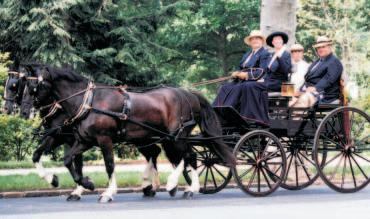

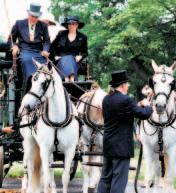
On Friday June 13 and Saturday,June 14, the sights and sounds ofSaratoga Springs,N.Y. could be seen and heard in and around Philadelphia.The Committee for An Evening in Old Saratoga,an event that has raised approximately $800,000 for the School’s New Bolton Center over the past dozen-plus years,reconstituted its weekend-long event in Philadelphia this year,where most ofthe Committee members have their roots.
More than a dozen antique carriages and road coaches came from places as far apart as Middleburg,Va.and Boston,Mass.,to support a weekend ofdriving and fundraising for New Bolton Center and the Devon Horse Show Foundation.A black-tie dinner dance and silent auction took place on Saturday evening at Ardrossan Farm in Villanova,Pa.,the inspiration for the Katherine Hepburn movie The Philadelphia Story,which gave the weekend its theme.A charming note from Miss Hepburn’s assistant advised that due to age and delicate health,Miss Hepburn would be unable to attend the gala,but she wished us good luck.Sadly, Miss Hepburn died just two weeks after the gala.
Nearly 330 guests from across the Philadelphia region,as well as others from Virginia, New Jersey,and New York,and places even further afield,danced to big band music,ate at tables decorated in the signature blue and yellow of An Evening in Old Saratoga,and bid on a variety ofitems displayed in the gorgeous
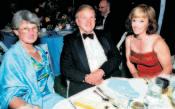
surroundings ofArdrossan Farm’s main house. Fabulous vacations,antiques,sporting art, gourmet meals,unique artifacts,and services made up the silent auction inventory.There was something to please everyone—even ifthat “everyone”already had “everything.”
The Committee of An Evening in Old Saratoga anticipates a stellar outcome from the fundraiser Beverly Ensor,the Board of An Evening in Old Saratoga,and the entire Committee have once again achieved a stunning
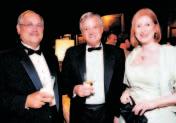
success in support ofNew Bolton Center.The School thanks them for their hard work,creativity,and resourcefulness,and we thank all who attended the Gala or brought coaches and horses for their wonderful generosity and enthusiasm for this event. Everyone looks forward to another fabulous weekend in June 2004!
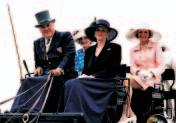
BELLWETHER 57 31
Phot ogr aph y b y A ddison Gear y/addisongear y .c om
The New BoltonCenter coach on Kelly Drive.
Mr.Bruce Rappaport and Mr.and Mrs.Wayne Grafton.
Mrs.Gretchen,CW’59,and Mr.Roy,C’61,Jackson and Betsy de Marino,V’80.
Mr. and Mrs. Hec tor Alcalde and Mrs.Beverly Ensor.
Upcoming Events
October 2003
11
Parents and Partners Day 2003
Philadelphia and New Bolton Center Campuses
Parents and partners offirst-year students receive an overview ofveterinary education at Penn Veterinary Medicine.For information,contact Amy Bogdanoff at (215) 898-4234 or via e-mail at <bogdanof@vet.upenn.edu>.
November 2003
19
2:00-4:00 p.m.
Veterinary Medical Alumni Society Executive Board Meeting
Alumni Hall
New Bolton Center
22
6:00 p.m.
Alumni Reception
American Association ofEquine Practitioners Annual Convention
Hilton New Orleans Riverside Hotel New Orleans,La.
For information,contact Joshua E.Liss at (215) 8981481 or via e-mail at <lissj@vet.upenn.edu>.
January 2004
10-17
Pennsylvania Farm Show 2004 Farm Show Complex Harrisburg,Pa.
Visit Penn Veterinary Medicine’s booth at the largest indoor agricultural event in America.
Penn Veterinary Medicine
3800 Spruce Street
Philadelphia, PA 19104-6008
Address Service Requested
18
8:00 p.m.
Alumni Reception
The North American Veterinary Conference Marriott Orlando World Center Hotel Orlando,Fla.
For information,contact Joshua E.Liss at (215) 8981481 or via e-mail at <lissj@vet.upenn.edu>.
28
2:00-4:00 p.m.
Veterinary Medical Alumni Society Executive Board Meeting Ryan Veterinary Hospital at Penn
February 2004
16
7:30-9:30 p.m.
Alumni Reception Western Veterinary Conference Mandalay Bay Resort Las Vegas,Nev.
Important Phone Numbers
Matthew J.Ryan Veterinary Hospital of the University of Pennsylvania
24-Hour Emergency Service(215) 898-4685 Specialist Clinic Appointments(215) 898-4680
George D. Widener Hospital for Large Animals at New Bolton Center
24-Hour Emergency Service and Specialist Clinic Appointments(610) 444-5800
School of Veterinary Medicine
General Information(215) 898-5438
March 2004
11-12
2004 Penn Annual Conference Adam’s Mark Hotel Philadelphia,Pa.
For information,visit <http://alumni.vet.upenn.edu/ pennannualconference.html>.
11
2:00-4:00 p.m.
Veterinary Medical Alumni Society Executive Board Meeting at 2004 Penn Annual Conference
May 2004
12
2:00-4:00 p.m.
Veterinary Medical Alumni Society Executive Board Meeting Alumni Hall New Bolton Center
17
Penn Veterinary Medicine Class of 2004 Commencement
July 2004
25
6:30 p.m.
Alumni Reception
American Veterinary Medical Association Annual Convention
Loews Philadelphia Hotel,33rd Floor Philadelphia,Pa.
For information,contact Joshua E.Liss at (215) 8981481 or via e-mail at <lissj@vet.upenn.edu>.
BELL WETHER 57SUMMER 2003 Visit the School’s website at www.vet.upenn.edu Nonprofit Organization U.S. Postage PAID Philadelphia, PA Permit No. 2563 Printed on recycled paper























































































